MTG (Meteosat Third Generation)
EO
ESA
Atmosphere
Ocean
Meteosat Third Generation (MTG) is a collaborative mission between the European Space Agency (ESA) and the European Organisation for the Exploitation of Meteorological Satellites (EUMETSAT) for the continuity of weather forecasting data. The mission will enhance current imager capabilities and include an new infrared sounding capability and real time lightning imaging for the early detection of severe storms, as well as host the Copernicus Sentinel-4 mission. There will be a total of six satellites launched, consisting of four MTG-I (Imager) satellites and two MTG-S (Sounder) satellites, with the first MTG-I satellite launched on 13 December 2022.
Quick facts
Overview
| Mission type | EO |
| Agency | ESA, EUMETSAT, COM |
| Mission status | Commissioning |
| Launch date | 13 Dec 2022 |
| Measurement domain | Atmosphere, Ocean, Land, Snow & Ice |
| Measurement category | Cloud type, amount and cloud top temperature, Liquid water and precipitation rate, Atmospheric Temperature Fields, Cloud particle properties and profile, Aerosols, Radiation budget, Multi-purpose imagery (land), Surface temperature (land), Vegetation, Surface temperature (ocean), Atmospheric Humidity Fields, Ozone, Trace gases (excluding ozone), Sea ice cover, edge and thickness, Snow cover, edge and depth, Atmospheric Winds, Lightning Detection |
| Measurement detailed | Cloud top height, Aerosol absorption optical depth (column/profile), Downward long-wave irradiance at Earth surface, Cloud cover, Cloud optical depth, Precipitation intensity at the surface (liquid or solid), Aerosol optical depth (column/profile), Cloud type, Cloud imagery, Aerosol Extinction / Backscatter (column/profile), Cloud drop effective radius, Vegetation type, Fire fractional cover, Short-wave Earth surface bi-directional reflectance, Atmospheric specific humidity (column/profile), O3 Mole Fraction, Atmospheric temperature (column/profile), Land surface temperature, Sea surface temperature, CH4 Mole Fraction, HNO3 (column/profile), NO2 Mole Fraction, Sea-ice cover, Snow cover, Cloud top temperature, Normalized Differential Vegetation Index (NDVI), Wind profile (horizontal), Atmospheric stability index, Volcanic ash, CO Mole Fraction, Wind profile (vertical), Sea-ice surface temperature, Total lightning density, HCHO Mole Fraction, Upwelling (Outgoing) spectral radiance at TOA |
| Instruments | IRS, UVN, FCI, LI |
| Instrument type | Imaging multi-spectral radiometers (vis/IR), Atmospheric chemistry, Atmospheric temperature and humidity sounders, Lightning sensors |
| CEOS EO Handbook | See MTG (Meteosat Third Generation) summary |
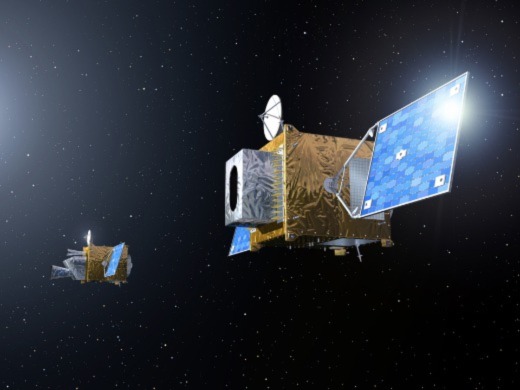
Summary
Mission Capabilities
The MTG-I satellites will accommodate the Flexible Combined Imager (FCI) and Lightning Imager (LI), whilst the MTG-S satellites will carry an Infrared Sounder (IRS) and a Ultraviolet Visible Near-infrared (UVN) Souder.
FCI is an optical imager that covers the visible, near-infrared and infrared spectrum with 16 channels. It offers significant enhancement in detection capabilities with respect to radiometric, spectral and spatial resolution over its predecessor, the Spinning Enhanced Visible and Infrared Imager (SEVIRI), resulting in improved forecasts and earlier prediction of severe weather events. The additional channels on FCI will improve the detection of thin cirrus clouds, aerosols, and localised fire events.
LI provides real-time data on the location and intensity of lightning flashes, to enable more precise forecasts of severe thunderstorms. The presence of lightning is a clear sign of atmospheric turbulence, which can be associated with extreme weather events. LI can detect all types of lightning: cloud to cloud, cloud to ground, and intra-cloud flashes, providing an advantage over ground based lightning detection networks.
IRS is a hyperspectral infrared sounder set to revolutionise weather forecasting by tracking the 3D structure of atmospheric water vapour and temperature for the first time on an operational basis. IRS includes the ozone band within the Long-Wave Infrared (LWIR) and the carbon monoxide band within Medium-Wave Infrared (MWIR). This will allow measurement within the free troposphere, leading to information on enhanced levels of pollution in the boundary layer below.
Performance Specifications
FCI will observe 16 channels in the visible and infrared spectrum, of which eight are placed in the solar spectral domain between 0.4 - 2.2 μm. FCI will operate at wavelengths between 0.3 - 13.3 μm, will have a spatial resolution of 1-2 km, and will be able to scan the full Earth disc in 10 minutes. FCI will also operate in a ‘high spatial resolution fast imagery mode’ which can zoom in on smaller areas and deliver data images of selected regions every 2.5 minutes, but for a tradeoff spatial resolution of 500 m.
LI consists of four identical optical telescopes. They will collectively and continuously measure at a wavelength of 777.4 nm with a very narrow bandwidth and a spatial resolution of 4.5 km at nadir, which will be triggered by optical pulses above a threshold that are initiated by lightning.
IRS uses interferometric techniques in two spectral bands, LWIR at 8.26 - 14.70 μm and MWIR at 4.44 - 6.25 μm, with a spectral resolution of 0.625 cm-1 and a spatial resolution of 4 km x 4 km. It will be able to cover the full disc of Earth in 60 minutes with a Europe Local Area Coverage (LAC) time of 30 minutes.
MTG satellites will all be in a geostationary equatorial orbit, positioned at a longitude of 0°.
Space and Hardware Components
The mission is planned to last more than 20 years in operation with the full MTG system consisting of six satellites, four MTG-I and two MTG-S. The industrial prime contractor for the MTG program is Thales Alenia Space of France with OHB (Otto Hydraulic Bremen) System AG as its partner. MTG-I and MTG-S will both use the SmallGEO (LUXOR) bus made by OHB-system AG. The launch weight will be approximately 3800 kg, comprising 2 tonnes of fuel which can last up to 10.7 years. The satellites have a nominal design life of 8.5 years.
The payload data downlink uses the Data Distribution Unit (DDU), which gathers the data to be transmitted to ground, a transmitter and Ka-band antenna. House keeping telemetry is downloaded in real-time through the S-band and Ka-band links, whereas the mission telemetry is downlinked in Ka-band only.
MTG (Meteosat Third Generation)
MTG is the next-generation European operational geostationary meteorological satellite system - a collaborative EUMETSAT/ESA program. Preparatory activities for the EUMETSAT MTG series started in late 2000 in cooperation with ESA, following the decision of the EUMETSAT Council to proceed with a Post-MSG User Consultation Process. The process is aimed at capturing the foreseeable needs of users of EUMETSAT's satellite data in the timeframe of 2015-2035. Typical development cycles of complex space systems are on the order of a decade or more. The current MSG (Meteosat Second Generation) system is expected to deliver observations and services until at least 2018.
MTG will continue services beyond this date and address future challenges in weather forecasting and other services for European citizens, such as improved air quality or UV-radiation warnings, as well as climate and atmospheric chemistry monitoring. 1) 2) 3) 4) 5) 6) 7) 8) 9)
In October 2008, an agreement was signed regulating the respective roles, responsibilities and financial commitments of the two organizations concerning future phases of the MTG program as well as the approval of the MTG payload complement:
• EUMETSAT will specify and consolidate the end-user requirements, the overall mission requirements, the space-to-ground requirements, and the ground segment requirements. In addition, EUMETSAT will be responsible for the overall mission and system engineering and ground segment design and development. Further along, it will fund the procurement of the recurring satellites, the launch services and launch and early orbit phases, and also execute commissioning and operations.
• ESA is responsible for the development and implementation of the space segment technologies and the first MTG twin satellites. ESA is funding the related cost, apart from 30% to be contributed by EUMETSAT. ESA will procure all recurring satellites as part of the EUMETSAT development and operations program.
The MTG series spacecraft and sensor complement are specified to be operated in-orbit for 20 years, compared to 15 years for MSG.
In March 2010, the MTG program took another step towards full approval with the EUMETSAT special Council, by accepting the MTG End-User Requirements Document which defines not only the deliverables to the user community, but also the duration of the operational service - at least 20 years for the imagery mission and at least 15 1/2 years for the sounding mission - the number of satellites, and the satellites in-orbit lifetime. 10)
• On February 25, 2011, the full MTG program entered into force. The consolidation of the full MTG program, as now approved, resulted from a long and intensive process through which the initial studies to define user needs for the post-MSG (Meteosat Second Generation) era led to the establishment of end user requirements for the new geostationary program, followed by the early definition phases of MTG until the end of 2007, when dedicated MTG activities started at EUMETSAT under the framework of the MTG Preparatory Program. 11)
- The SRR (System Requirements Review) for the space segment was completed in April 2011. This is being followed by preparation of the PDR (Preliminary Design Review) for late 2011.
Timeframe | Activities |
2001-2005 | User Consultation Process & Pre-Phase-A Studies (Phase 0) |
2006-2008 | MTG (Phase-A): Feasibility studies of selected mission concepts. Approval process of MTG preparatory program. The Phase-A studies were successfully concluded in December 2008. |
2009-2010 | Phase-B: Detailed design activities under coordinated EUMETSAT and ESA Preparatory Programs, with approval processes for coordinated MTG development programs |
2011-2018 | Phases C/D: Development and testing of the MTG system elements |
2019 onwards | Phase E: Nominal need date for MTG series. Launch, operations and utilization of MTG spacecraft |
Requirements
More than 50 leading experts in a variety of disciplines were involved, representing operational and research organizations from Europe, the United States and other international partners, as well as WMO (World Meteorological Organization). The definition of the requirements was driven by the EUMETSAT customers’ long-term strategic objectives, namely the most business-critical improvements to meteorological and environmental services to be achieved in the 2015-2025 timeframe. The main customers include National Meteorological Services and other operational organizations from EUMETSAT Member States, the ECMWF (European Centre for Medium-Range Weather Forecasts) and EUMETNET. Identification of candidate observing techniques was also performed, together with the preliminary assessment of their capabilities and suitability to satisfy customer needs. 12) 13) 14)
Based on these assessments, five candidate observation missions were identified for MTG: 15)
- HRFI (High Resolution Fast Imagery) mission. For MTG, the most stringent requirement is the absolute geolocation knowledge error needed for the HRFI imaging mission: the Earth location of acquired samples needs to be determined with accuracy (knowledge) better than 250 m at SSP (Subsatellite Point) (i.e. 7 µrad for a sample distance of 0.5 km) with a 68.26 % confidence level over the HRFI coverage.
Further, the timeliness requirements are also very demanding. For the HRFI imagery level 1b data need to be delivered within 150 seconds of their acquisition. This sets constraints on the number of observations that can be accumulated and used in the image navigation processing. Therefore, efficient algorithms for the processing of image and on-board data are requested.
- FDHSI (Full Disk High Spectral Imagery) mission
- IRS (Infrared Sounding) mission. For the IRS sounder, the requirement is more relaxed, and amounts to 800 m at SSP (i.e. 22 µrad) and at 68.26% confidence over a LAC (Local Area Coverage), equivalent to a quarter of the Earth. However the sounder has a demanding pointing stability requirement of 300 m at SSP and at a 68.26% confidence level, over the dwell time of about 9 seconds.
- LI (Lightning Imagery) mission
- UVS (UV-VIS Sounding) mission.
Regarding the MTG missions, the satellite availability shall be at least 96% calculated on an annual basis for the duration of the satellite nominal operational life. From this outage, 1% is allocated to unscheduled outages (e.g. safe mode) and 3% to scheduled outages (e.g. station keeping maneuver and operations like satellite decontamination). Therefore disruptions due to orbit control maneuvers must be minimized, using appropriate station keeping strategies and satellite performances.
INR (Image Navigation and Registration) requirements: An INR system concept, generally applicable to all MTG instruments, but exemplified here for the FCI only, has been developed during the Phase A study. The concept has some affinity to the GOES-N INR system (Ref. 15).
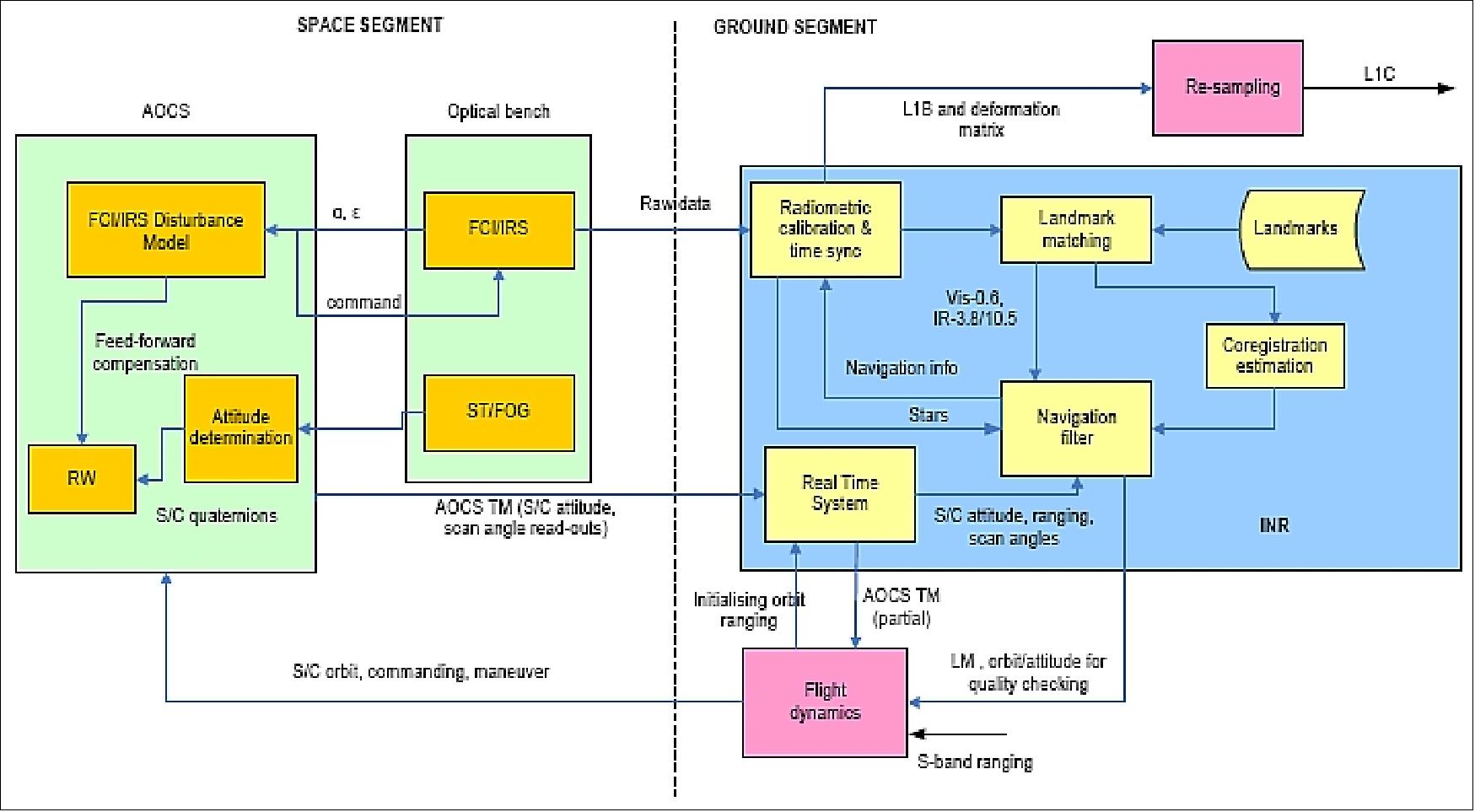
The INR system shown in Figure 1 has been chosen for the simulation to prove the feasibility to MTG geolocation requirements. On the satellite, a combination of star tracker and gyroscope are the essential elements to determine the space bus attitude. The ST (Star Tracker) determines an absolute pointing reference while the gyroscope records relative changes in the accelerations. The star tracker uses an on-board star catalog, which is uploaded to the spacecraft (about every six months). Star tracker and gyro data are inputs to the Attitude Determination unit which calculates the necessary updates of the attitude. A control signal is sent to the reaction wheels (RW) to point the spacecraft towards the center of the Earth and correct for bus disturbances. The bandwidth of the control signal is typically significantly smaller than the bandwidth of the signals coming from the ST/gyro unit, which is providing typically gyroscope measurements of some tenth of Hertz.
The basic orbit and attitude estimation accuracy performance that can be obtained with standard tracking system and on-board attitude sensors is insufficient for meeting the image navigation requirements of MTG. The performance of this basic approach is therefore complemented by a simultaneous INR processing based on instrument observations. The derived performance estimates from simulations indicate that the combined approach is sufficient for fulfilling the MTG INR and operational requirements.
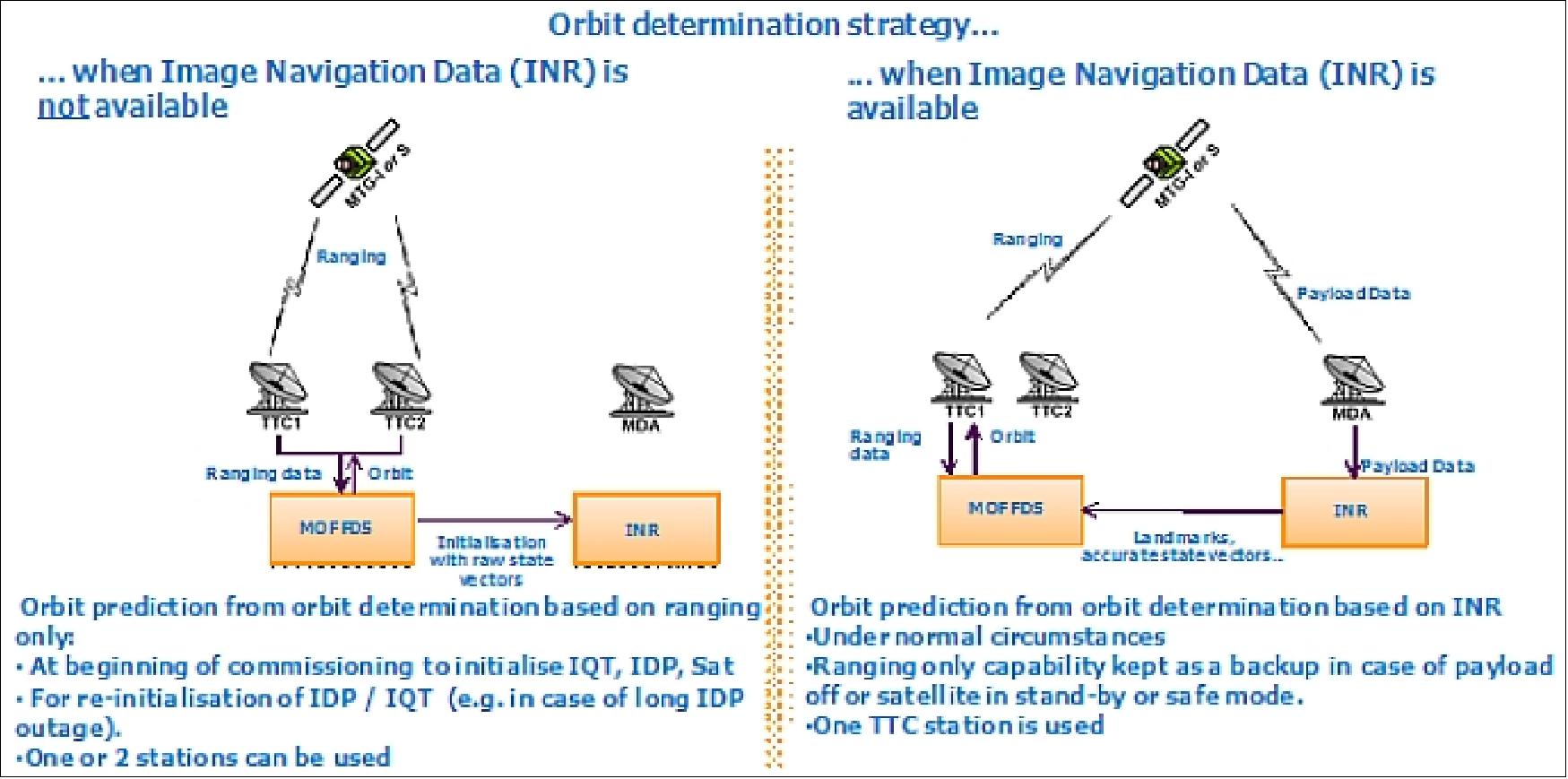
Space Segment
Following Phase-A studies and consolidation of MTG mission definition, a baseline for the EUMETSAT/ESA Phase-B activities and for the preparation of the EUMETSAT full MTG Program Proposal was agreed composed of the Flexible Combined Imager (FDHSI and HRFI missions), the IRS (Infrared Sounder) mission, the LI (Lightning Imager) mission and the accommodation of GMES Sentinel 4 instrument (UVS mission) to be provided by ESA. 16)
The MTG satellite system concept is based on a twin configuration of 3-axis stabilized satellites:
• MTG-I (MTG-Imaging mission satellite)
• MTG-S (MTG- Sounding mission satellite)
The target date for the operational deployment of the MTG space segment element, ensuring continuity of the the imagery mission, is now the end of 2018. This requires a launch in early 2018 with a one year commissioning phase anticipated for the the new MTG system, including ground and space segments. Figure 3 shows the baseline MTG deployment strategy. This has a direct impact on the envisaged overall mission development and deployment schedule. High mission and satellite reliability and availability are required combined with the nominal and extended mission lifetime for both the MTG-I and MTG-S satellites. 17)
EUMETSAT, in coordination with ESA and industry, have established priorities vis-à-vis of the overall mission. The highest priority being for the Imaging missions (HRFI + FDHSI), which will provide continuity to the current MSG mission.
The EUMETSAT MTG program includes overall system activities, development of the ground segment, procurement of the recurrent satellites. The imagery mission will consist 4 MTG-I satellites, whereas the sounding mission will be fulfilled with 2 MTG-S satellites.
It is planned to use a common bus design for the MTG-I and MTG-S satellites with local adaptations as required per mission. It is expected that the following bus subsystems will be largely common for both satellite types:
- Structure (separate mechanical interfaces are foreseen for the two payload complements)
- Thermal (conventional thermal control design envisaged)
- Attitude and Orbit Control (similar design approach for both satellites)
- Propulsion (based on a chemical propulsion system)
- Electrical Power (being modular to adapt the power needs as required per satellite type)
- Command and Data Handling (similar design envisaged for both satellites with adaptation per satellite)
- Telemetry, Tracking and Command (heritage of existing conventional S-band systems).
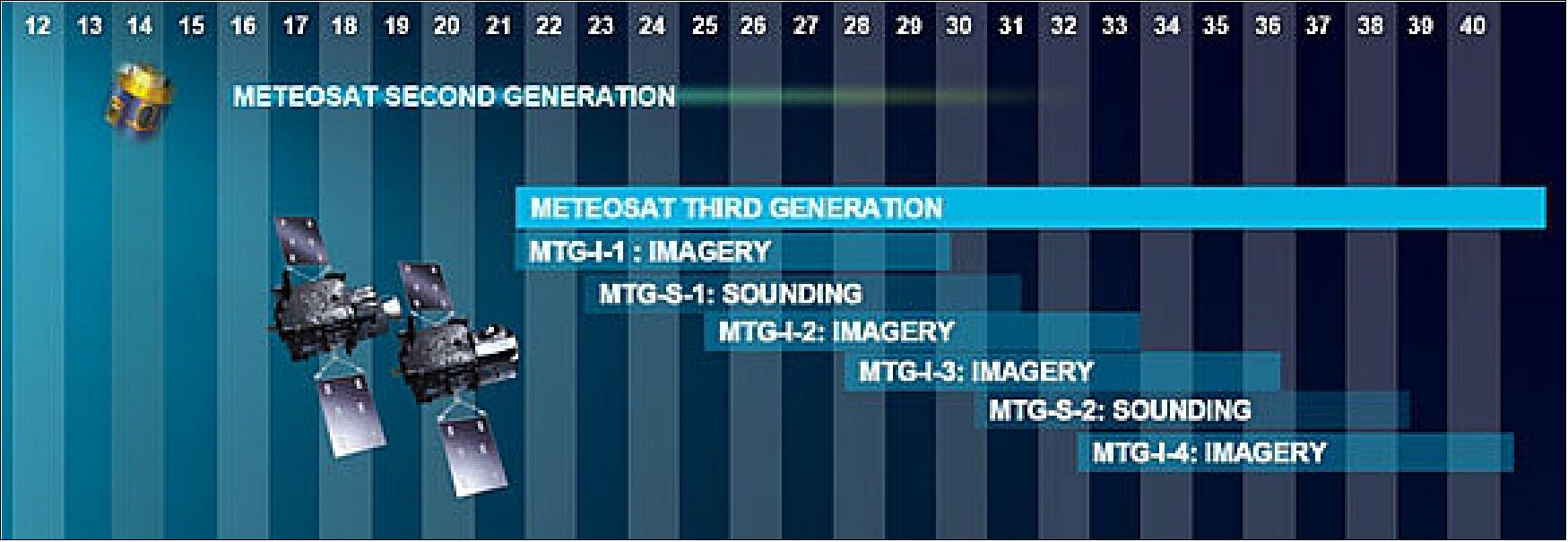
Following on from MSG (Meteosat Second Generation), MTG is a cooperative venture between EUMETSAT and ESA, and will ensure continuity of high-resolution meteorological data to beyond 2037. The cooperation on meteorological missions between EUMETSAT and ESA is a success story that started with the first Meteosat satellite in 1977 and continues today with the MSG series and the polar-orbiting MetOp series.
In February 2010, ESA selected a consortium led by TAS (Thales Alenia Space) of France and Italy and OHB Technology of Germany with its subsidiary Kayser Threde (KT) to build Europe's next-generation meteorological satellites. The six MTG spacecraft - four imaging and two equipped with sounders - will operate from GEO (Geostationary Earth Orbit). However, the decision does not mean an immediate contract for the winning team. Instead, ESA will enter into final negotiations with TAS and OHB to settle open issues. 19) 20) 21)
On Feb. 24, 2012, ESA and TAS signed the MTG contract. Thales Alenia Space leads the industrial consortium that is building the MTG family. Along with being the prime contractor, TAS is responsible for the MTG-I imaging satellite, including the primary payload, the FCI (Flexible Combined Imager). Bremen-based OHB is responsible for the MTG-S satellites and the provision of the common six satellite platforms, supported by Astrium GmbH as the System Architect. The IRS (Infrared Sounder), to be flown on MTG-S, will be developed by Kayser Threde. 22)
Earth observation missions | - FCI: 10 minute FDC (Full Disk Coverage), 21 bands between 0.4 and 13.3 µm, very high INR performances |
Operations | - 8.5 years in-orbit lifetime / 10.7 years for propellant |
External interfaces | - UVN accommodation on MTG-S |
Programmatics | - 4 MTG-I and 2 MTG-S flight models |
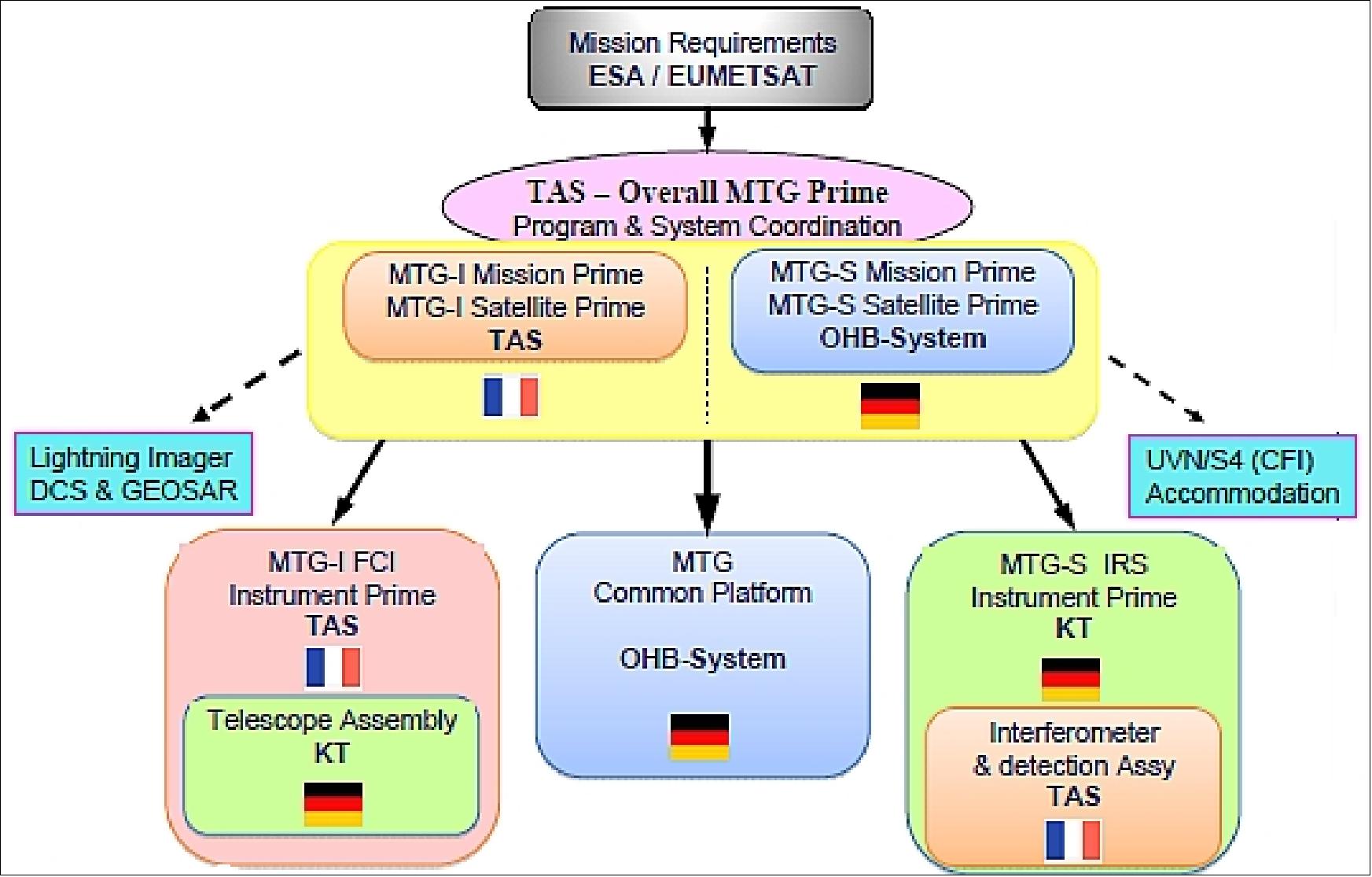
Overview of main technical challenges of the MTG series (Ref. 21)
MTG-I Spacecraft
• Significantly higher performances than MSG, similar to GOES R (of NASA/NOAA)
• Transition from spinner to 3 axis concept
- Solar entrance in instrument cavity
- Two axis scanning
• IR performance requires active cooling at 55 K
• Main technical challenges: attitude measurement & pointing stability, compensation of scan motion by reaction wheels, INR, LWIR detectors, scan mechanism, active cryocooling, instrument thermal architecture (sun effect), micro vibrations & other attitude perturbations.
MTG-S Spacecraft
First Geo IR sounder of this class in the world (NOAA has stopped the GOES R sounding mission (HES)
• Many technical challenges solved on MTG-I
• IRS FTS concept derived from IASI
• Huge data rate (3 GByte/s at instrument output) / real time acquisition and processing
• Pointing stability over 10 s
• Higher resolution of imagery: 0.5 to 2 km instead of 1 to 3 km
• 16 more accurate spectral bands instead of 12
• Repeat cycle 10 minutes instead of 15 minutes
• Data rate around 60 Mbit/s instead of 3 Mbit/s
• More challenging INR requirements, combined with 3 axis stabilization introduction
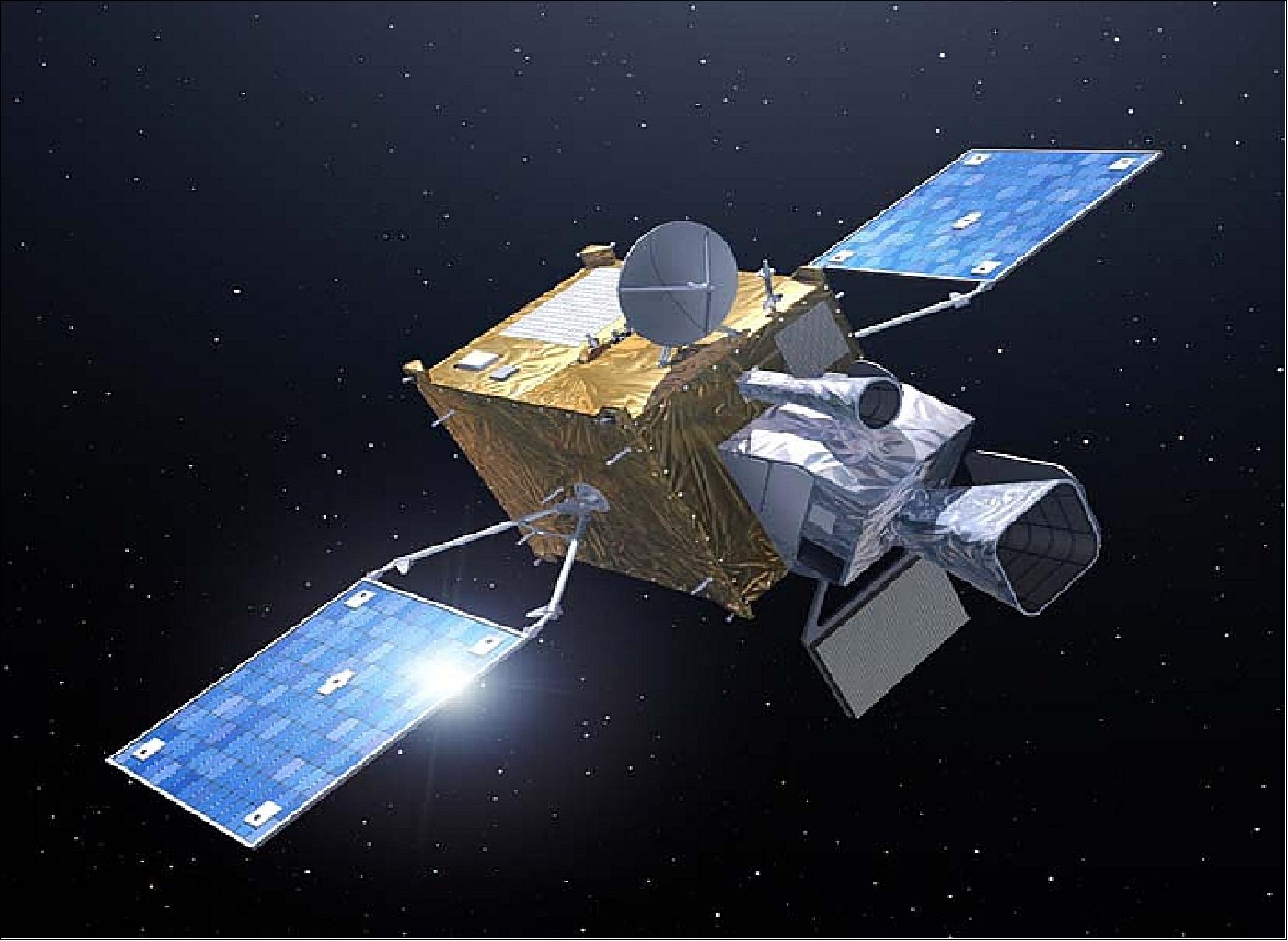
Structure: A two-winged satellite configuration is selected, which minimizes the solar momentum build-up and therefore the reaction wheels off-loading frequency and its associated mission outage. A yaw flip is performed around each equinox, to ensure that the satellite –Y side is always protected from sun illumination, which is beneficial to the thermal control of the instruments and AOCS fine sensors.
AOCS (Attitude and Orbit Control Subsystem): The AOCS supports a “fine pointing mode” to provide high pointing stability. Attitude determination is based on high performances gyrometer and multi-head star trackers necessary to ensure an accurate and stable Earth pointing. To make the most of their performances, the AOCS fine sensors have been accommodated inside the platform towards its cold side. This configuration is indeed the only one which provides sufficient protection with respect to the varying sun illumination conditions, and minimizes therefore the attitude restitution errors at sensors level. Actuation is provided by 5 reaction wheels, enabling the avoidance of zero crossing and the related outage. The reaction wheels are off-loaded by the thrusters. The reaction wheels are also in charge of the compensation of the disturbances induced by the instruments mechanisms (FCI or IRS). Microvibrations are minimized by implementing isolating devices for the main disturbances which are the reaction wheels and the instruments cryocoolers.
EPS (Electrical Power Subsystem): The EPS architecture relies on a regulated 50 V bus with current limiter protections. Power conditioning and battery management are autonomous and based on dedicated hardware functions. A PCDU (Power Conditioning and Distribution Unit) provides all the satellite units with the necessary equipment regulated lines and thermal heater distribution.
Part of the EPS is also the actuator SADA (Solar Array Drive Assembly), a subsystem which rotates the solar panels, ensuring proper orientation of the solar cells towards the sun. The common physical architecture of SADA consists of three key components: SADM (Solar Array Drive Mechanism) and SADE (Solar Array Drive Electronics), that drive the SA (Solar Array). The operation of a SADA, by nature an electromechanical kinematic chain, generates disturbance loads resulting in microvibrations of the structure.
The susceptibility of the payloads leads to flow microvibration emissivity requirements down to all the moving parts of a satellite that contribute eventually to the overall micro-vibration emission budget of a spacecraft. The SADAs are constrained by microvibration emission requirements more and more stringent, to be verified by analysis and/or by test. Ruag Space of Switzerland is the SADA developer for the MTG satellites. 24) 25)
Avionics: The MTG spacecraft are based on a central avionics architecture, with central OBSW (OnBoard Software) in charge of all satellite subsystems and instrument high level management. The SMU (Satellite Management Unit) is at the core of the MTG spacecraft, and provides the processing resources and the interfaces to all platform units and the bus management. It is also the master of spacecraft autonomy and FDIR (Failure Detection, Isolation and Recovery) functions.
The satellite OBSW is based on a modular and hierarchic architecture, providing standard “bus” interfaces to all applications. System management (modes transitions, FDIR recovery actions) is parametrized by a system database and based on On-Board Procedures or action sequences.
The on-board architecture relies on 3 main communication buses:
• 1 MIL-STD-1553 dedicated to platform units
• 1 MIL-STD-1553 for the command and control of instrumentation
• A high rate SpaceWire (SpW) network dedicated to payload data and high rate payload telemetry.
The architecture furthermore ensures the modularity and parallel development of instruments and platform modules, through the following payload related functions:
• The ICU (Instrument Control Units), which are in charge of the FCI and IRS (most complex instruments) management and data-processing. The ICU is part of each instrument.
• The PDD (Payload Data-Downlink), which is in charge of the payload data acquisition and high rate downlink in Ka-band.
• A Common MTG Packet User Standard (MTG tailoring), which is implemented in the platform and instrument software.
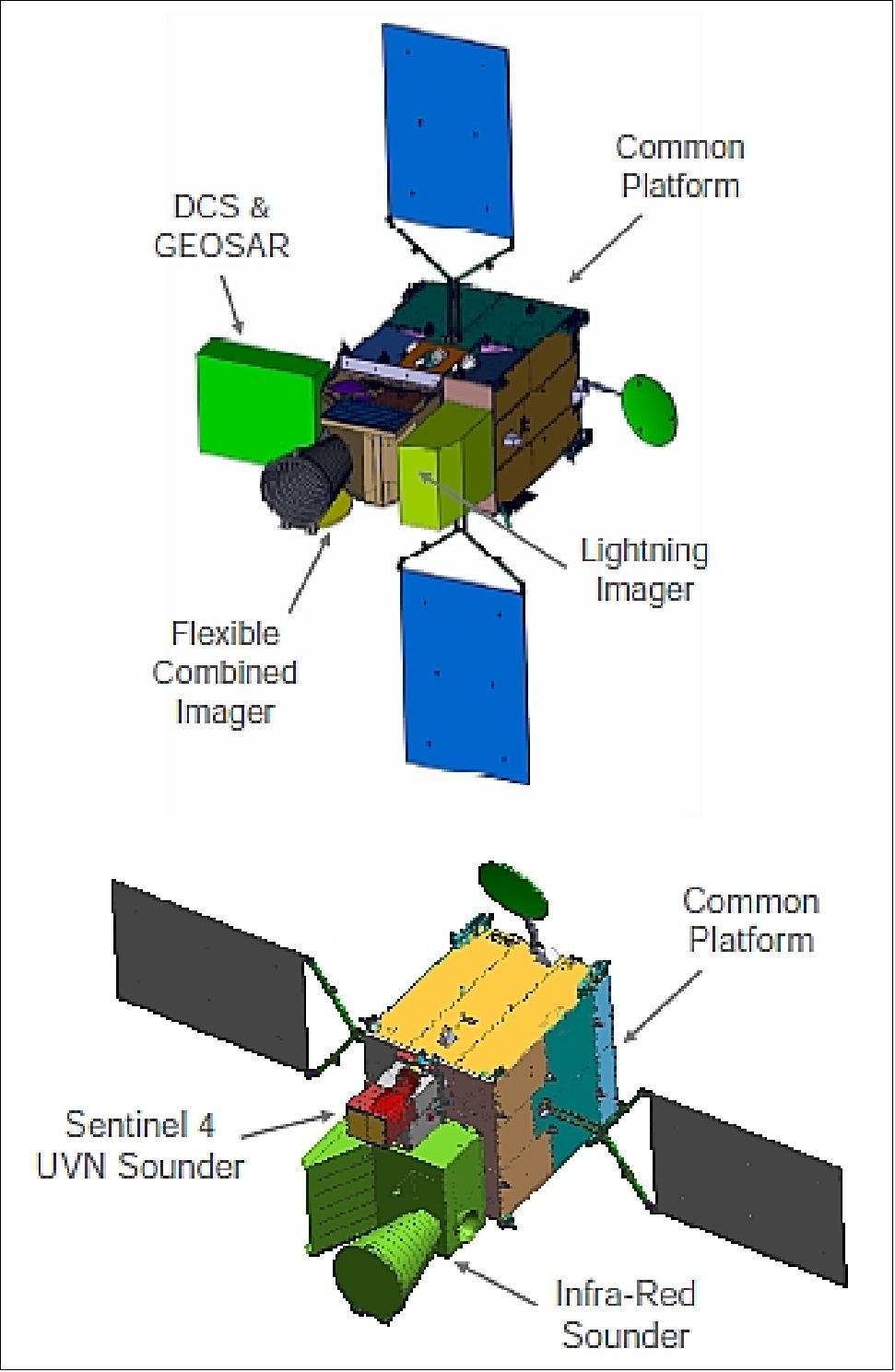
MTG SpaceWire Architecture
The MTG satellites accommodate, respectively, the FCI imager, LI imager and the DCP digital transponder for the Imager S/C (or MTG-I), and the IRS and UVN sounders for the Sounder S/C (or MTG-S), over a payload SpaceWire network for mission data distribution and instrument’s configuration with a total high rate telemetry of 295 Mbit/s (Imager S/C) and 557Mbit/s (Sounder S/C) after RS (Reed Solomon) concatenated encoding and encryption. 26) 27)
The payload data network is built around a DDU (Data Distribution Unit) that implements SpaceWire (SpW) routers for 3 instruments (FCI, LI, DCP or IRS1, IRS2, UVN) communication and one SMU (Satellite Management Unit) computer for INR auxiliary data collection and network management. The network supports full cross-strapping between each terminal (instrument’s and SMU) and DDU leading to a total of 16 terminal ports based on to independent nominal and redundant DDU SpaceWire-10X routers.
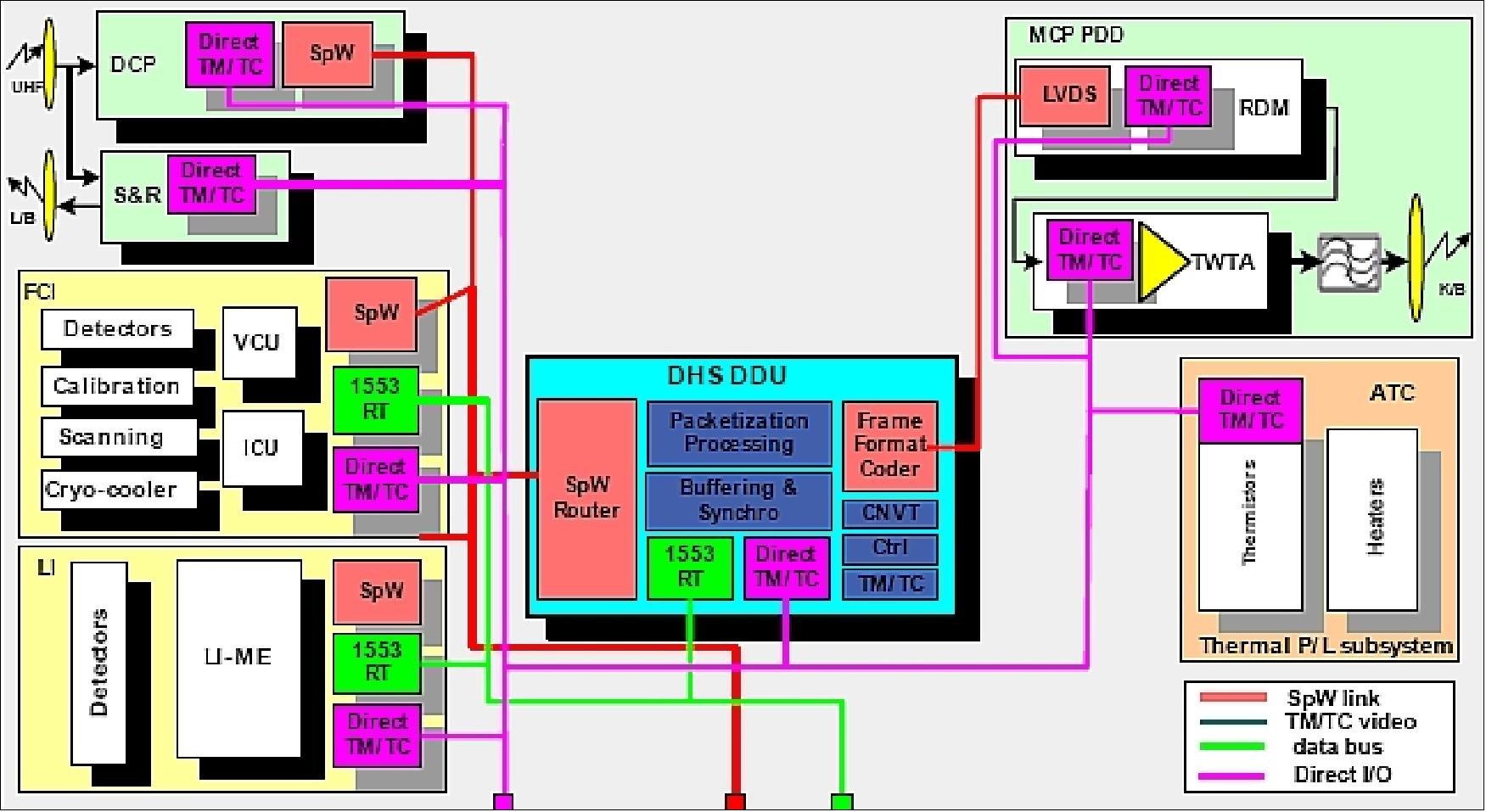
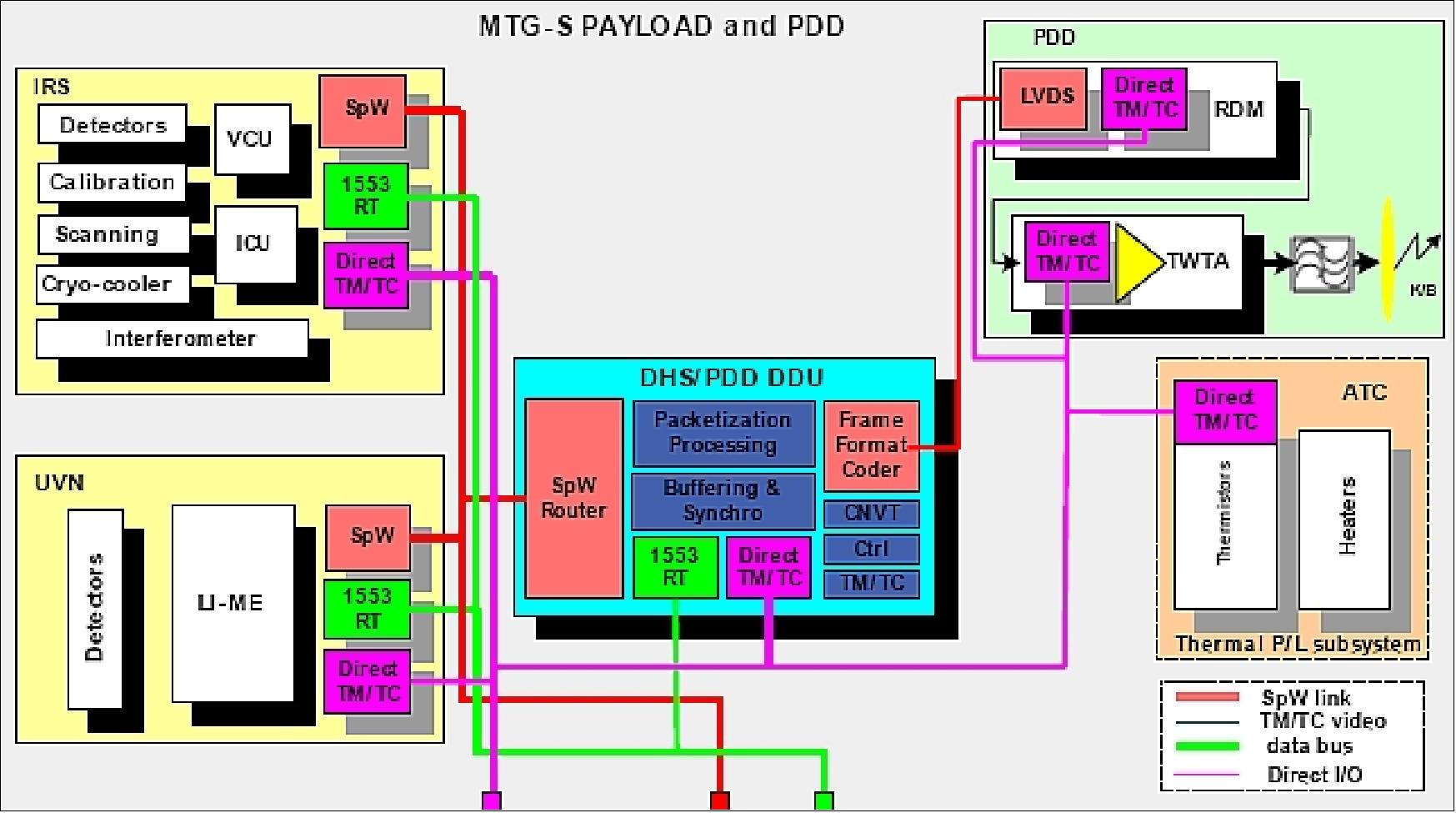
The network architecture is identical for both imager and sounder configurations. The network is running at 200 Mbit/s on all links providing large margins. The large margin vs data distribution and the asynchronous behavior of the SpW link, allow to accommodate variable instrument’s data flow according to their operational modes. For example the UVN instrument provides 40 Mbit/s in normal mode or 125 Mbit/s in commissioning mode.
The SpaceWire time code distribution is not used for payload synchronization due to the instrument heritage: a classical OBT (On-Board Time) associated to a PPS (Precise Positioning Service) pulse is broadcast through the payload Mil-Std-1553 command control bus.
Thanks to the implementation of SpW routers, the full-duplex capability of the SpW is used for command/control messages required to configure quickly the instruments without outage: large configuration tables are loaded from SMU mass memory into the instruments through SpW links; i.e. 135 Mbit of data are transferred between 2 consecutive image acquisitions.
All messages are formatted with ECSS (European Cooperation for Space Standards) PUS (Packet Utilization Standard) and distributed over the SpW network with the ECSS SpW CCSDS transfer protocol, using the user field for identifying the virtual channel for the high telemetry destination.
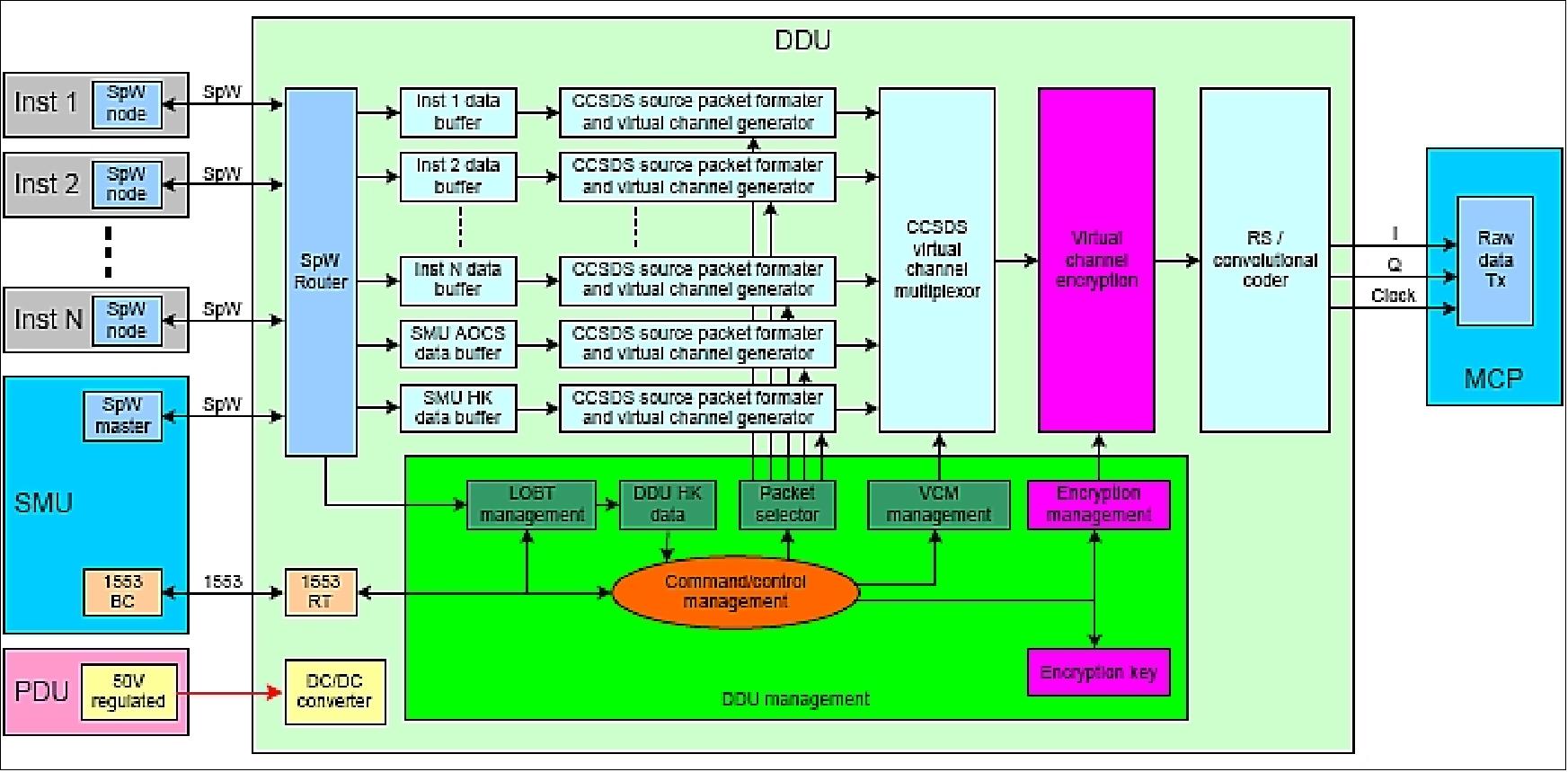
The MTG satellites are the first space mission in a TAS contract for implementing and using the complete SpW network capability with a full cross-strapping redundancy with SpW-10X routers and full duplex used for command/control configuration messages with large tables (Ref. 26).
RF communications: Use of S-band for TT&C functions. The S-band subsystem consists of redundant transponders and two hemispherical TT&C antennas. The payload data downlink uses the DDU (Data Distribution Unit), which gathers the data to be transmitted to ground, a transmitter and Ka-band antenna. The latter is folded at launch and then deployed once in orbit. It is mounted on a two-axis pointing mechanism so as to ensure accurate pointing of the spot beam towards the MTG ground station before and after the yaw flip, and when the satellite is repositioned on the geostationary arc.
House keeping telemetry is downloaded in real-time through both S-band and Ka-band links, whereas the mission telemetry is downlinked in Ka-band only.
Propulsion module: The propulsion module is accommodated on the platform central tube and shears webs. The MON (monopropellant) and MMH (Monomethylhydrazine) tanks are inside the tube. Further subsystems are: Helium tanks, the thrusters and LAE (Liquid Apogee Engine), the associated tubing, valves and pyros.
Astrium has developed a Unified Propulsion System (UPS), which is adapted for the MTG satellites and offers a complete pre-integrated drive system with 16 (sixteen) 10 N thrusters for orbit and attitude control, and one 400 N apogee engine, all fuelled from two propellant tanks (925 l) with hydrazine (MMH) and nitrogen tetroxide (NTO). After its release from the launch rocket, the 400 N apogee engine will propel the satellite from GTO to GEO . At this stage, the majority of the fuel, around 80% of the total, will have been expended. The remaining 20% of the fuel will serve the satellite’s 16 thrusters to maintain its exact orbit path for the 13-year mission, and for any adjustments required. 28)
Parameter | MTG-I series spacecraft | MTG-S series spacecraft |
Spacecraft launch mass | 3400 kg class | 3600 kg class |
Spacecraft power | 2 kW, solar array of 10.7 m2 | 2 kW, solar array of 10.7 m2 |
Data rate | 165 Mbit/s | 260 Mbit/s |
Spacecraft lifetime | In orbit lifetime 8.5 years, consumables for 10.7 years | In orbit lifetime 8.5 years, consumables for 10.7 years |
Mission Status
• July 3, 2023: ESA, along with European Organisation for the Exploitation of Meteorological Satellites (EUMETSAT), released the first animations from the Lightning Imager onboard the first MTG satellite, which was launched on 13 December 2022.
Each animation contains a sequence of images created by collecting one minute’s worth of lightning measurements, overlaid on a single image of Earth from the Lightning Imager.
• December 13, 2022: The first Meteosat Third Generation satellite, the imager MTG-I1, was launched at 20:30 UTC on an Ariane 5 launcher from the Guiana Space Center in Kourou, French Guiana. The launch dates for subsequent satellites in the series MTG-S1, MTG-I2, and then later, at the time of renewal of the operational fleet, MTG-I3, MTG-S2 and MTG-I4 were then calculated from the time of the first launch. 61)
• April 20, 2022: As one of the last milestones before liftoff at the end of the year, the first Meteosat Third Generation weather satellite was being fitted with its Lightning Imager. From geostationary orbit, 36,000 km above Earth’s surface, this instrument continuously monitors lightning over more than 80% of Earth’s disc for early warnings of dangerous storms. It is capable of imaging relatively weak lightning events in full sunlight. 29) Following on from the first and second generations of Meteosat satellites, the Meteosat Third Generation (MTG) mission should deliver essential data for weather forecasting from geostationary orbit for the next two decades. The MTG mission comprises two types of satellite: four MTG-Imagers and two MTG-Sounders.
- The first MTG-I, MTG-I1, is scheduled for liftoff at the end of the year. MTG-I1 has already been equipped with one of its instruments, the Flexible Combined Imager, which will deliver a full image of Earth every 10 minutes to monitor and forecast the weather. It can also zoom in to deliver images of selected regions every 2.5 minutes. MTG-I1's other main instrument is the Lightning Imager. Lightning, which can occur from cloud-to-cloud or cloud-to-ground, is a sign of turbulence in the atmosphere and can be used in meteorological modelling as an early indicator of the development of severe weather events.
- The continuous monitoring for lightning by the all-new Lightning Imager should enable this – it should allow for the early detection of severe storms and therefore be able to issue timely warnings, and it will also be particularly relevant for air traffic safety. Its detectors are so sensitive that relatively weak lightning events can be detected, even when it is full daylight. This will add to the capability of the US Global Lightning Monitor, which is carried on the GOES satellites, and has shown significant contribution to the overall nowcasting capability. Imagers, which detect rapid and localised energy emissions, could be used for other applications such as potentially tracking meteorite events.
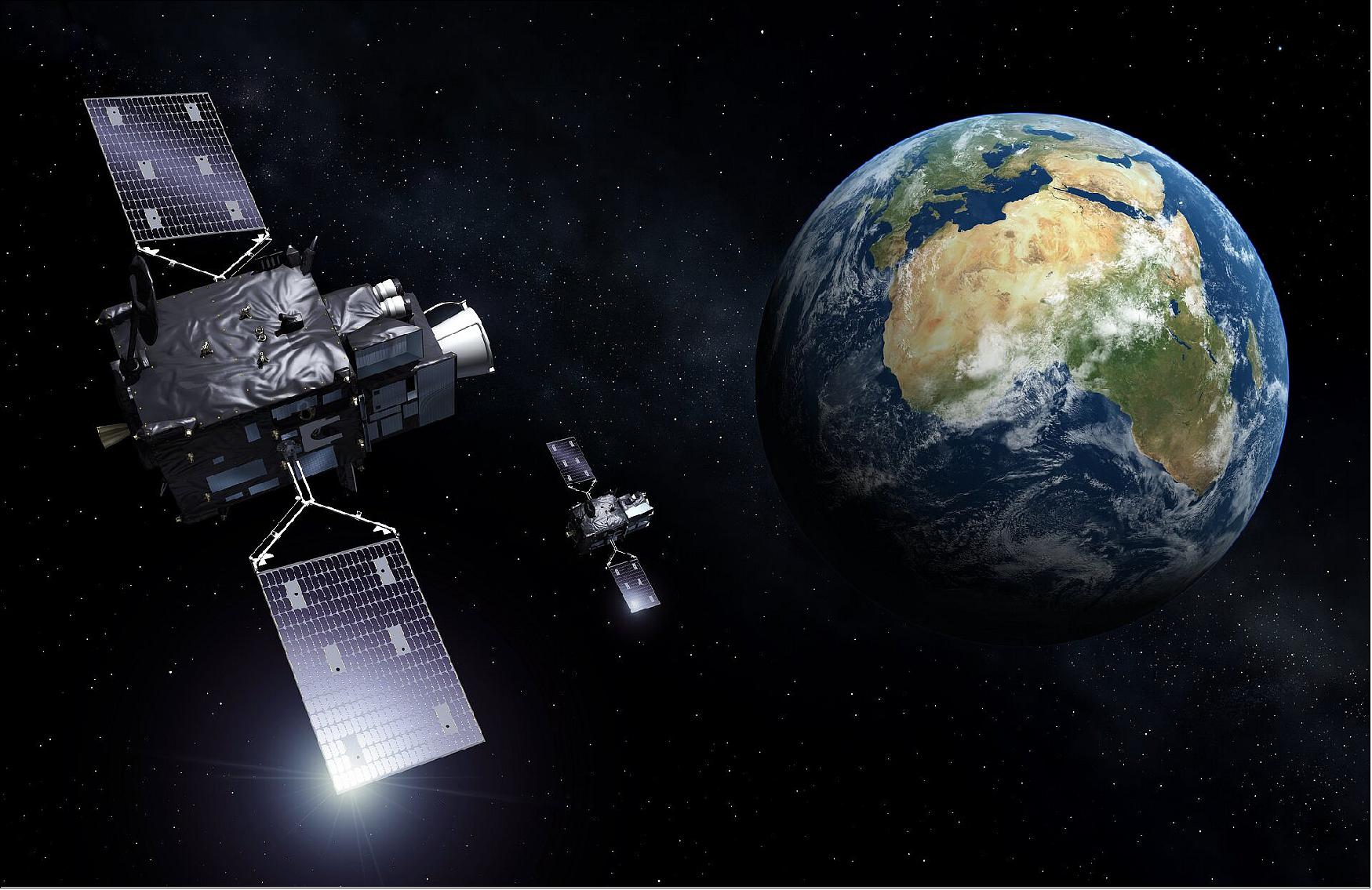
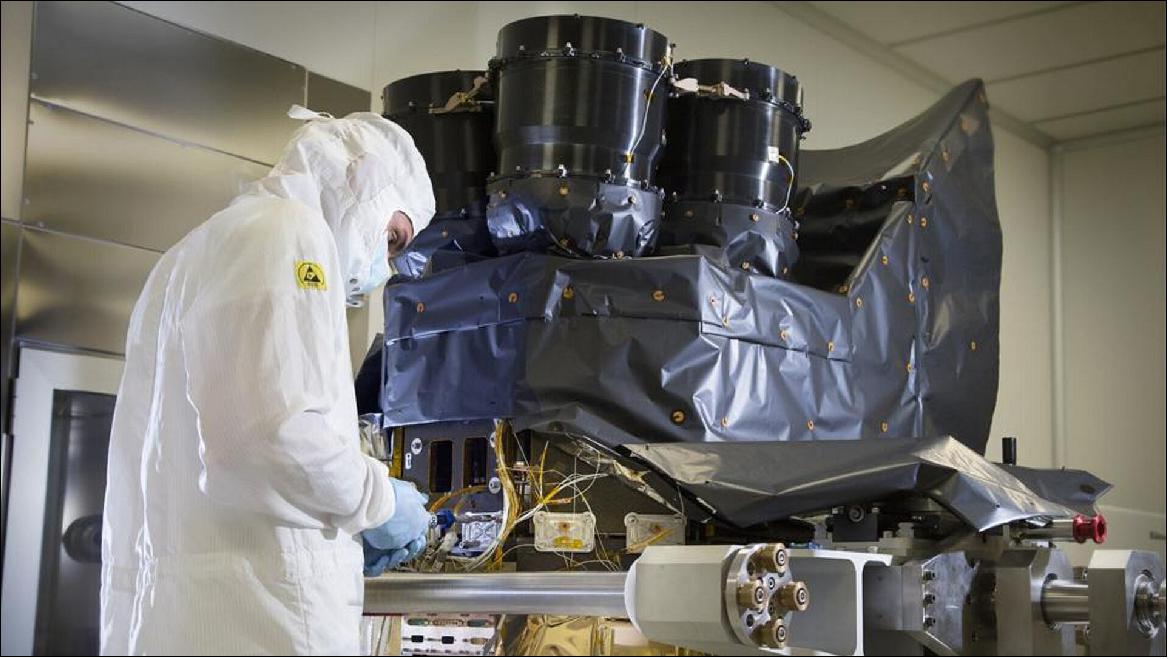
March 23, 2022: With extreme weather events threatening to be more frequent and more severe as the climate crisis takes grip, it has never been more important to have fast and accurate forecasts. ESA and EUMETSAT are working hard to ensure that there will be a constant stream of weather data from space for the next decades and that these data will arrive faster and be more accurate compared to what we have today. It is therefore fitting that on World Meteorological Day, ESA can be assured that the first of the next generation weather satellites, Meteosat Third Generation Imager, has passed a critical set of tests, paving the way for it to be launched in December. 30)
- Following the first and second generations of Meteosat satellites, the Meteosat Third Generation (MTG) will soon take over to ensure the continuity of data for weather forecasting, from geostationary orbit, for the next two decades. This new generation of weather satellite will offer a significant enhancement of the current imager capabilities provided by the Meteosat Second Generation (MSG), a real-time lightning imaging capability and an all-new infrared sounding capability providing early detection of the development of severe storms. The MTG mission comprises two types of satellite: four MTG-Imagers and two MTG-Sounders.
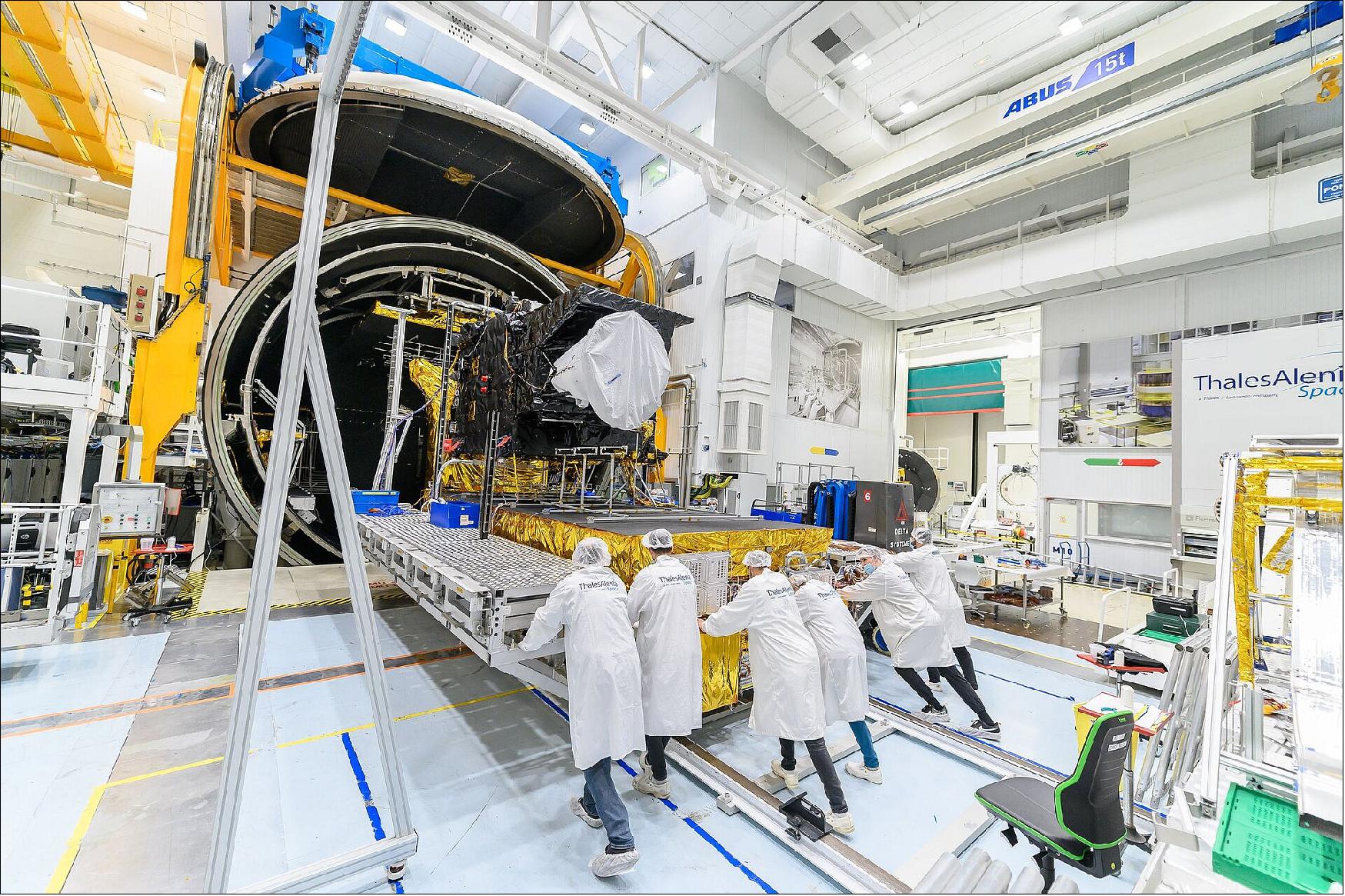
- The MTG-Imager satellites carry the Flexible Combined Imager instrument which is natural successor of the Spinning Enhanced Visible and Infrared Imager (SEVIRI) carried on the current Meteosat Second Generation satellites. Where SEVIRI has 12 spectral channels, the Flexible Combined Imager has 16 channels. It operates at wavelengths between 0.3 and 13.3 microns, and has a spatial resolution of 1–2 km delivering a full image of Earth every 10 minutes. In addition it can operate in a ‘high spatial resolution fast imagery’ mode, which can ‘zoom in’ on smaller areas of the Earth disc with four spectral channels, but with increased spatial resolution (to 0.5 km) and delivering data images of selected regions every 2.5 minutes. After removal from the chamber alignment tests confirmed that no detectable impact on instrument alignments had taken place and the satellite was then prepared for a suite of mechanical tests, which have now also been completed. ESA is responsible for the definition and implementation of the MTG satellites and procurement of recurrent hardware, while EUMETSAT is in charge of operating the spacecraft throughout its lifetime. The MTG satellites will replace the current Meteosat Second Generation operational system.
• September 2, 2021: After many technical and programmatic challenges, the first satellite of the next generation of the Meteosat family has taken a major step towards its first flight, currently scheduled for launch in autumn 2022. 31) The new generation of weather satellites will offer a significant enhancement of the current imager capabilities provided by the Meteosat Second Generation, a real-time lightning imaging and an all-new infrared sounding capability for early detection of severe storms. Following the completion of the first flight model of the Flexible Combined Imager (FCI) in July of this year, the instrument has now been successfully mounted onto the protoflight platform and the combined assembly is now being prepared for the Satellite Thermal Vacuum campaign, which is scheduled to start in early October in Cannes, France. Prior to this, the Flexible Combined Imager, developed by Thales Alenia Space, had undertaken an extensive system and environmental test campaign, which concluded with the complex ‘Optical Vacuum’ performance testing which measured all the critical optical and radiometric characteristics of the instrument. The testing confirmed the expected state-of-the-art performance of the instrument.
- In parallel, the three-axis stabilized platform, developed by OHB in Bremen, had also undertaken extensive system testing demonstrating the platform’s performance and associated data handling links with the instruments. The platform had also participated in the System Validation Test (SVT) where it was successfully commanded from both Telespazio (demonstrating the nominal Launch and Early Orbit phase sequence) and Eumetsat, the European Organisation for the Exploitation of Meteorological Satellites, (for routine operations). The MTG-I1 satellite will be the first of six satellites being developed in the frame of the MTG contract, from which four ‘Imager’ satellites (MTG-I) and two ‘Sounder’ satellites (MTG-S) are being procured. The first MTG-S satellite is also progressing and is on track for launch readiness towards the end of 2023. Developed by OHB, the Infrared Sounder is under final assembly in Munich, and is scheduled for instrument mechanical testing towards the end of this year.
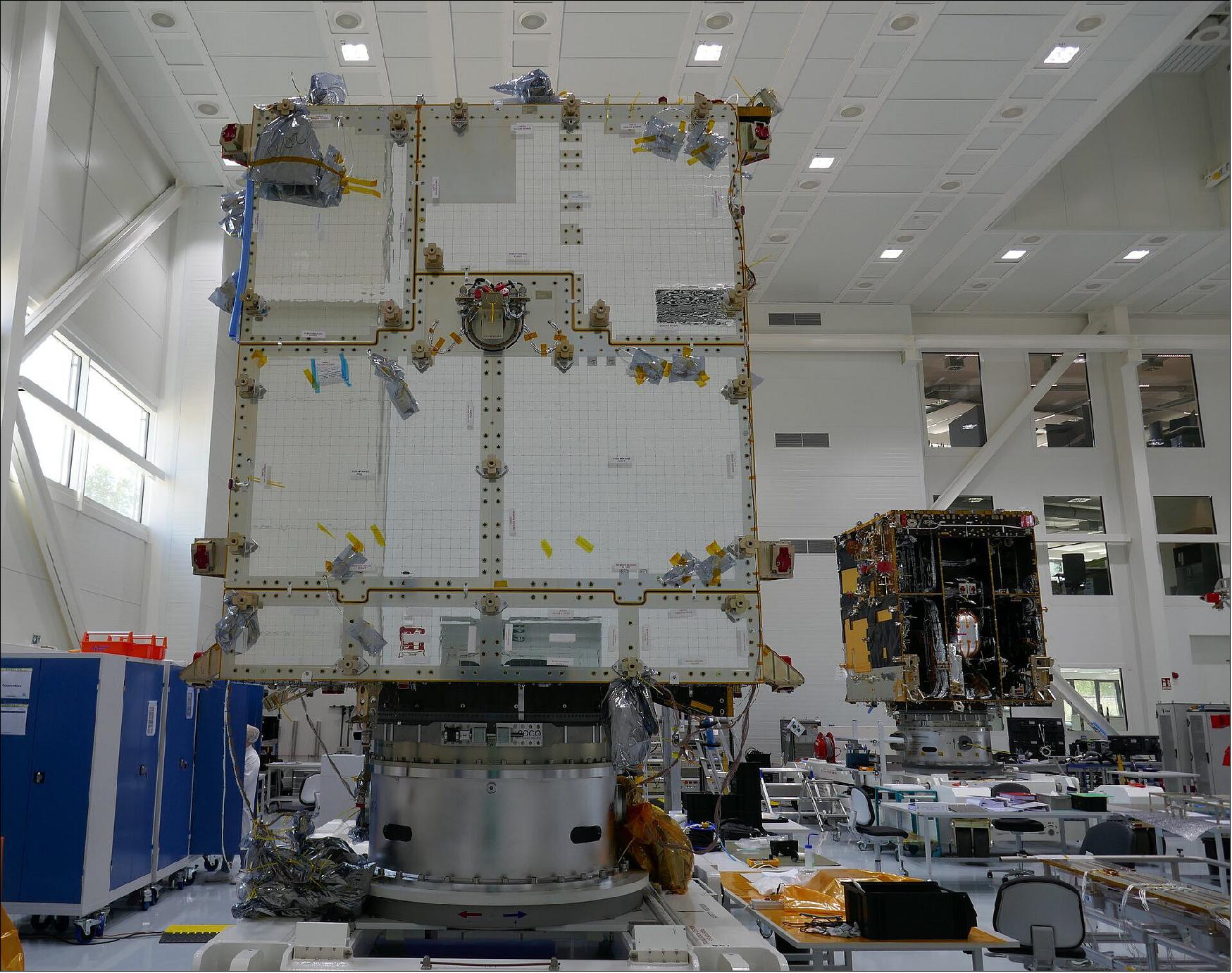
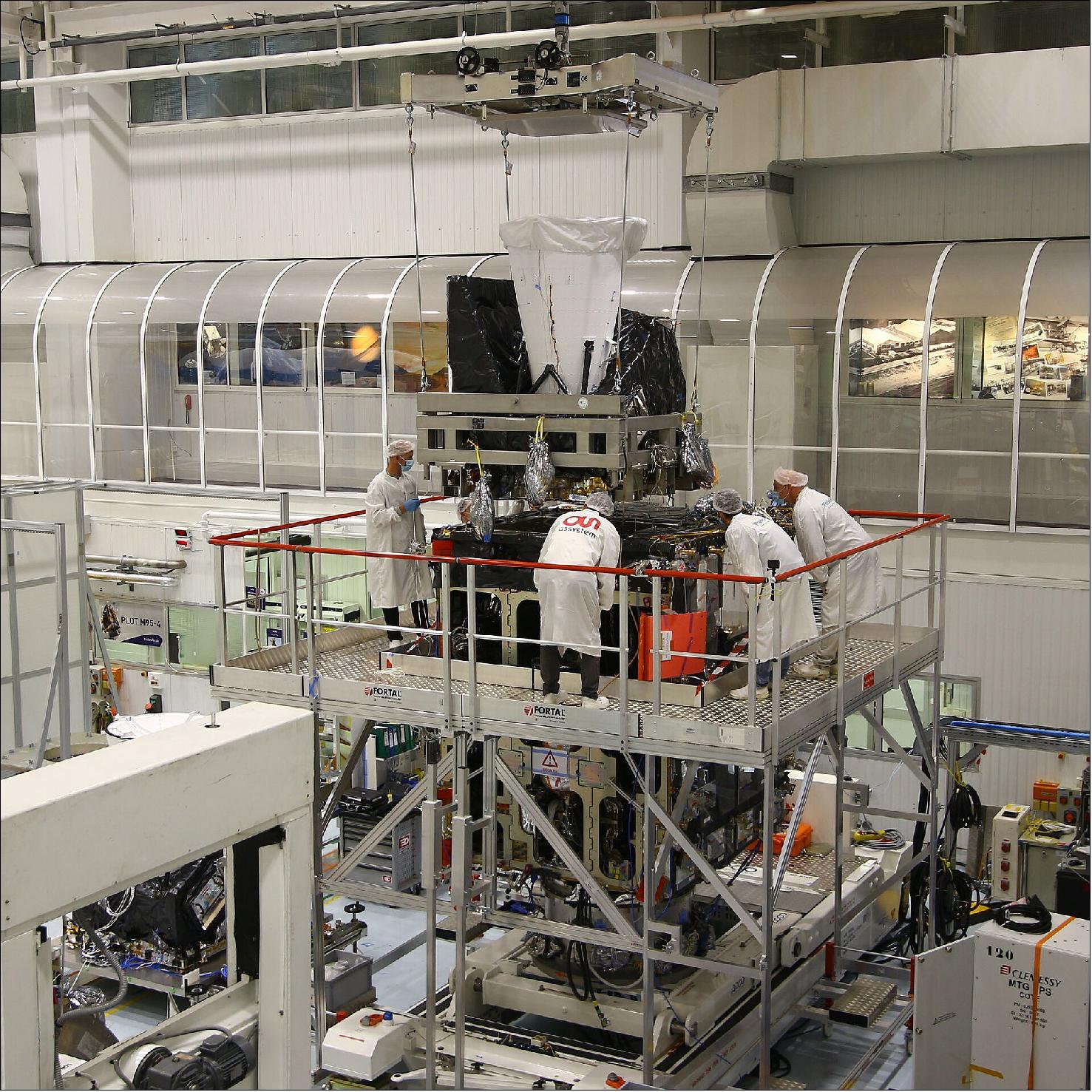
• July 7, 2021: From ESA’s Materials and Electrical Components Laboratory – one of a suite of labs based at the ESTEC technical centre in Noordwijk, the Netherlands – a view from an intricate test campaign for the next generation of European weather satellites. 32) The near infrared detector assembly of the Flexible Combined Instrument (FCI) imager aboard the MeteoSat Third Generation – Imaging (MTG – I) satellite was found to be susceptible to unwanted ‘stray light’ from the Sun. A solution was proposed to reduce this vulnerability: a very thin metal mask would be glued atop the assembly, with carefully designed slits that would allow light to penetrate only in the desired areas, minimizing the entry of stray light. However, the feasibility of this solution needed to be tested, in order to demonstrate if the alloy cover would remain securely in place as incoming direct sunlight heats it up repeatedly during moments of sun intrusion.
- A new feature was added to the Electrostatic Discharge (ESD) facility, part of the Materials and Electrical Components Lab. Originally designed as a vacuum chamber to expose samples to mono-energetic electrons down to cryogenic temperature, the ESD was upgraded to host an optical rack to hold a light source to simulate sunlight exposure onto the sample. Thanks to this – removable – option, the detector could be exposed to light of varying intensity across thousands of cycles.
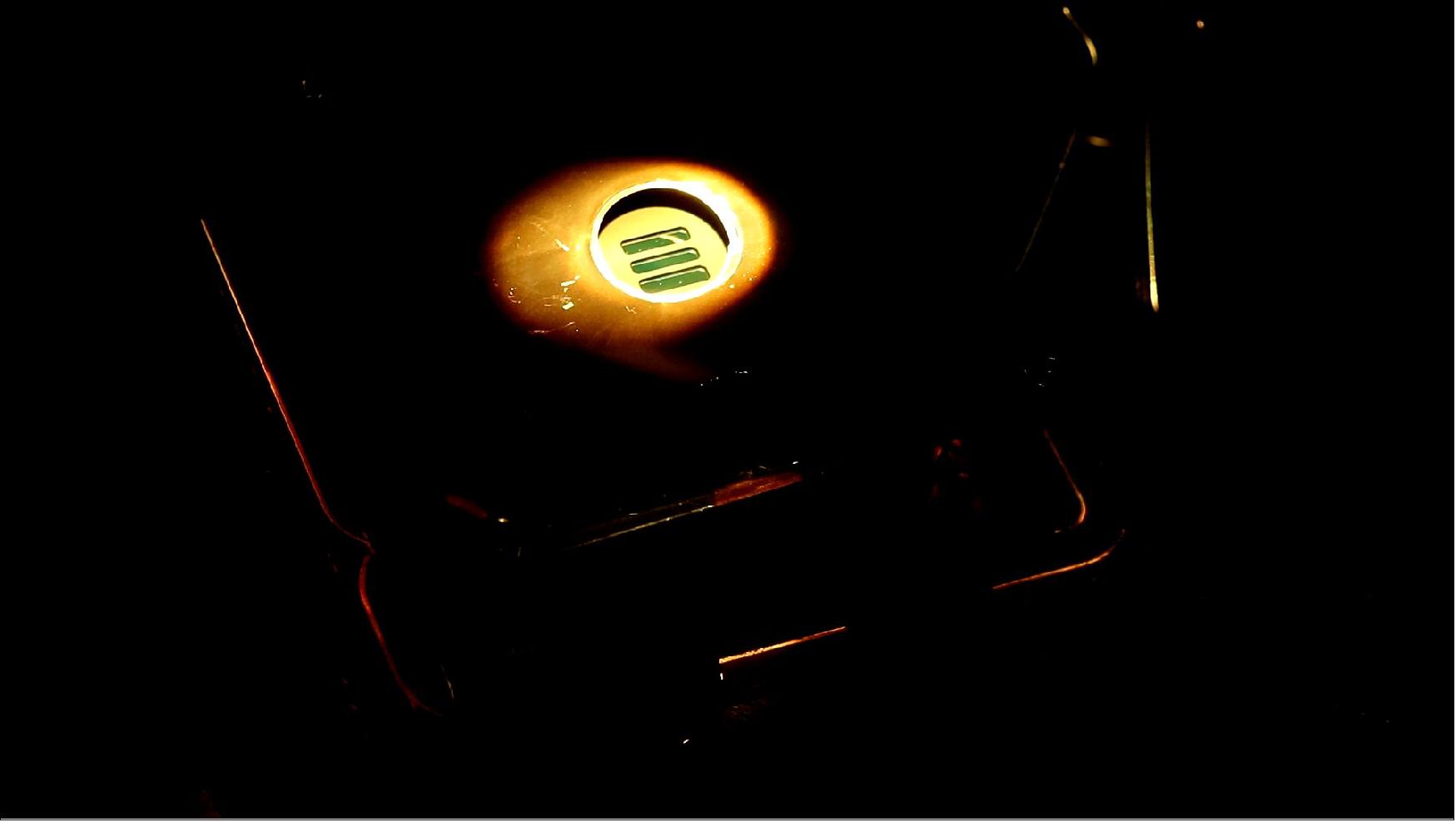
• March 23, 2021: Arianespace and EUMETSAT signed an update of their Launch Services Agreement for two MeteoSat Third Generation (MTG) satellites. 33) The sounder satellite MTG-S1 and the imager satellite MTG-I2 will be launched with Ariane 6, the next generation of Ariane family of launchers. Arianespace will also place into orbit the MTG-I1 satellite with an Ariane 5 launcher by the end of 2022. The launch orderbook includes two more state-of-the-art meteorological polar satellites as well as one additional launch, still an option. The launch planning will see MTG-S1 satellite be placed into orbit in the first half of 2024, while the MTG-I2 would be planned for the second half of 2025 onwards. In both cases, the satellites will be reaching Geostationary Earth Orbit, a destination made reachable by high-standard capacities of Ariane 6. Both organizations also confirmed that Arianespace will place into orbit the MTG-I1 satellite with an Ariane 5 launcher by the end of 2022. The launch orderbook includes two more state-of-the-art meteorological polar satellites (METOP-SG A1 and METOP-SG B1) as well as one additional launch.
• July 3, 2019: This mesh-based model of Europe’s future Meteosat Third Generation Imager (MTG-I) satellite has helped select the optimal location of the radio frequency antennas used to send it commands and downlink mission telemetry. 34)The model gives engineers insights into the resulting radio frequency characteristics of the satellite itself. The colors indicate the induced electromagnetic response of adjacent surfaces when these antennas are active. The red spot in the corner of the satellite body indicates the location of one of these S-band microwave antennas used for ‘telemetry, tracking and telecommand’, with another out of view on the satellite’s opposite side. The other colors show the resulting current across MTG-I, from orange on antenna-facing surfaces down to yellow, then green and finally the minimum intensity in blue. This helps antenna engineers to calculate the ‘link budget’ or overall coverage and efficiency of these antennas in different positions, across both stowed and deployed configurations. This model was prepared for MTG-I by ESA’s Antenna Computational Facilities (ACF), part of the Agency’s Antenna Test Facilities, based at its ESTEC technical center in the Netherlands. Equipped with state-of-the-art software, the ACF solve complex electromagnetic problems across the entire radio spectrum in cooperation with European universities and industry.
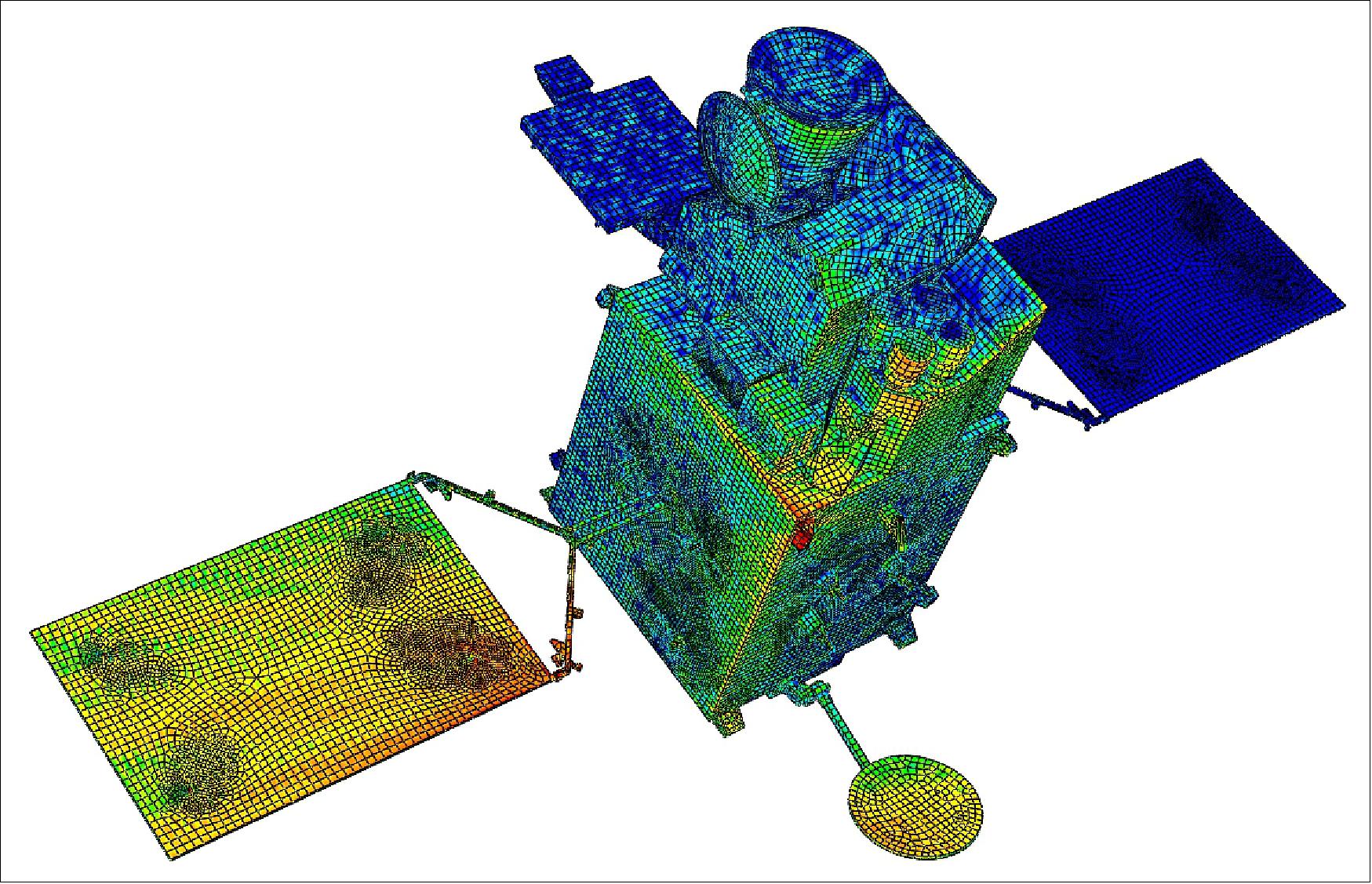
• July 2, 2019: With the first in the next generation of Meteosat satellites due to be launched in a couple of years, an important milestone has been passed, further paving the way for better weather forecasts – something on which we all rely. 35) Building on the long-standing partnership between ESA and Eumetsat, the success of both the first generation of Meteosat missions and the current Meteosat Second Generation series, Meteosat Third Generation (MTG) will soon take over the reins of providing critical data from for weather forecasting.
- While this third generation of weather satellites guarantees the continuity of data for weather forecasting from geostationary orbit, the combination of its higher resolution images and state-of-the-art sounding products is set to take weather forecasting to the next level. To ensure the continuity of data for at least the next 20 years and to provide the wide range of observations needed by meteorologists, the mission is based on a series of two types of satellite: four MTG-Imagers and two MTG-Sounders. With the first satellite, an MTG-I, due to be launched in 2021, engineers are busy designing and testing various parts of this substantial craft. It has now not only passed its ‘critical design review’, which means that everything is in place for it to be built, but tests have also shown it will be able to withstand the rigors of liftoff. It was also subjected to a separation test using the actual launch vehicle adapter. The purpose of which was to carefully check for design flaws and any integration defects.
• July 4, 2018: A test model of the main imager, FCI (Flexible Combined Imager), for Europe’s forthcoming MTG (Meteosat Third Generation) weather satellite is being lifted towards Europe’s largest vacuum chamber for simulated space testing. 36) 37)Developed by Thales Alenia Space, this is a ‘structural and thermal model’ test version of the mammoth Flexible Combined Instrument, which will provide state of the art measurements of Earth’s atmosphere across 16 visible and infrared channels. The flight version of this instrument will serve aboard the Meteosat Third Generation-series of imaging satellites, dubbed MTG-I. Developed in conjunction with EUMETSAT, Europe’s weather satellite organization, these satellites will be accompanied by additional MTG ‘sounding’ satellites in geostationary orbit to provide simultaneous vertical profiles of the atmosphere.
- Some 15 m high and 10 m in diameter, the Large Space Simulator – located at ESA’s ESTEC technical center in the Netherlands – is cavernous enough to accommodate an upended double decker bus. Once the top and side hatches are sealed, high-performance pumps create a vacuum a billion times less dense than standard sea-level atmosphere, and this is held for weeks at a time during test runs. A Sun simulator shines intense light on the test item at the same time that liquid nitrogen is pumped through the walls to recreate the cold of space in the shade.
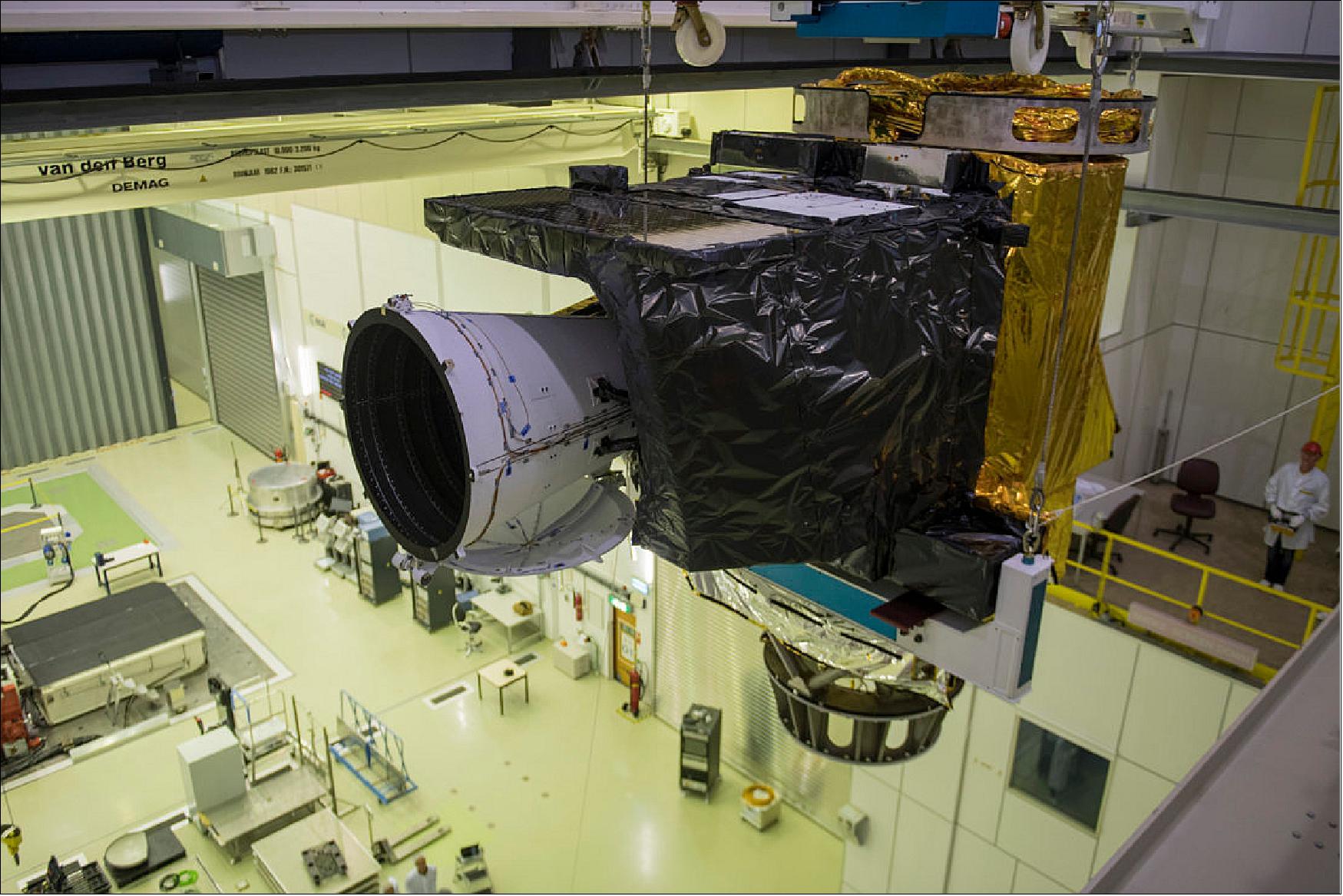
Launch
The first MTG-I1 spacecraft launched on board an Ariane 5 launcher on December 13, 2022, from the Guiana Space Center in Kourou, French Guiana.
Orbit
MTG-I1 is located in geostationary orbit at an altitude of approximately 35,786 km, with the nominal longitude at MTG-I-1 is 0º.
Sensor Complement
The payload for MTG-I series consists of the FCI (Flexible Combined Imager), LI (Lightning Imager), DCS (Data Collection System), and search and rescue from GEO (GEOSAR). 38) 39) 40)
The payload for MTG-S series is comprised of two instruments: the IRS (Infrared Sounder), and UVN (Ultraviolet Visible Near-infrared) Sounder. The UVN sounder will be provided by ESA as part of the Copernicus program and is referred to as the “Sentinel-4 GEO component mission”.Hence, a separate file, Sentinel-4, is provided on the eoPortal which describes only the UVN Sounder.
FCI (Flexible Combined Imager)
FCI is the follow-on instrument of SEVERI (Spinning Enhanced Visible and Infrared Imager) heritage flown on the MSG series missions of EUMETSAT which started with the launch of MSG-1 (Meteosat-8) on Aug. 28, 2002. Originally, there were two successor instruments defined for MTG - namely HRFI (High Resolution Fast Imagery) and FDHSI (Full Disk High Spectral Resolution Imagery) - whose requirements were eventually combined into one instrument named FCI (Flexible Combined Imager). This implied also some descoping actions of the requirements: 41) 42) 43) 44)
- Drop of the capability of targeted observations (selectable area 6º x 6º)
- Reduction of FCI channels to 16 - originally considered: 28
- Redefinition of FCI channels more in line with current MSG SEVIRI performances
- Relaxation of longest wavelength channels (13.3 µm) compatible with more mature detectors technologies - originally considered: up to 14.9 µm.
The key requirements for FCI spatial and temporal data resolutions remain unchanged, namely:
• Spatial resolution: 0.5 / 1.0 km (solar channels) and 1.0 / 2.0 km (thermal channels)
- For imagery on local scales (1/4 of full disk) the spatial resolution is 0.5 km with 4 channels at high spatial resolution 0.5 km (2 solar), and 1.0 km (2 thermal channels)
- For full disk imagery the spatial resolution is 1 km (8 solar channels) and 2 km (8 thermal channels)
• Temporal resolution: BRC (Basic Repeat Cycle) = 10 minutes for a full disk image; BRC = 2.5 minutes for local scale (Europe / North Atlantic) retrievals.
The relaxations adopted by the MMT (MTG Mission Team) result in a system:
- which is less risky
- and has a more efficient development - by still enabling to fulfil the user’s needs.
The FCI instrument will outperform the SEVERI observations on cloud, aerosol, moisture and fire detection by adding new channels and by improving temporal-, spatial-, and radiometric resolution of the data.
Spectral band (µm) | Center wavelength (µm) | Spectral width (µm) | SSD (Spatial Sampling Distance), km |
VIS 0.4 | 0.444 | 0.060 | 1.0 |
VIS 0.5 | 0.510 | 0.040 | 1.0 |
VIS 0.6 | 0.640 | 0.050 | 1.0, (0.5) #1 |
VIS 0.8 | 0.865 | 0.050 | 1.0 |
VIS 0.9 | 0.914 | 0.020 | 1.0 |
NIR 1.3 | 1.380 | 0.030 | 1.0 |
NIR 1.6 | 1.610 | 0.050 | 1.0 |
NIR 2.2 | 2.250 | 0.050 | 1.0, (0.5) #1 |
IR 3.8 | 3.800 | 0.400 | 2.0, #2 (1.0) #1 |
WV 6.3 | 6.300 | 1.000 | 2.0 |
WV 7.3 | 7.350 | 0.500 | 2.0 |
IR 8.7 | 8.700 | 0.400 | 2.0, (2.0) #2 |
IR 9.7 (O3) | 9.660 | 0.300 | 2.0 |
TIR 10.5 | 10.50 | 0.700 | 2.0, (1.0) #1 |
TIR 12.3 | 12.30 | 0.500 | 2.0 |
TIR 13.3 | 13.30 | 0.600 | 2.0 |
The channels VIS 0.6, NIR 2.2, IR 3.8 and IR 10.5 are delivered in FDHSI spatial sampling and HRFI spatial sampling configurations. The spatial sampling and spectral requirements for the HRFI sampling configuration are indicated by #1. The fire application channels are marked with #2. All other channels are delivered in FDHSI sampling configuration. In total, up to 22 image colors and sampling configurations could be delivered by each image cycle, covering all the needs.
In the nominal imaging mode, the FDHSI covers the full Earth disk with a 10 minutes BRC (Baseline Repeat Cycle). RSS (Rapid Scan Services) are provided thanks to coverage equivalent to BRC/n referred to as LAC (Local Area Coverage). The LAC coverage can be variably placed anywhere over the Earth (this shall be taken into account for the scan mechanism qualification).
In particular for the FCI coverage, will be used for the RSS. The images will be delivered with the following considerations:
- Imagery data will now be delivered to the users at level 1c, e.g. after image rectification
- Co-registration error is specified at level 1b as knowledge; the end performances are to be determined after image rectification
- In-flight absolute and relative image geometric quality of FCI will be assessed after image rectification, so that high accuracy landmark processing can be fully applied
- The image quality process will be applied also for the IRS data, only for in-flight performance verification. However, the sounding data will be delivered to the users before rectification.
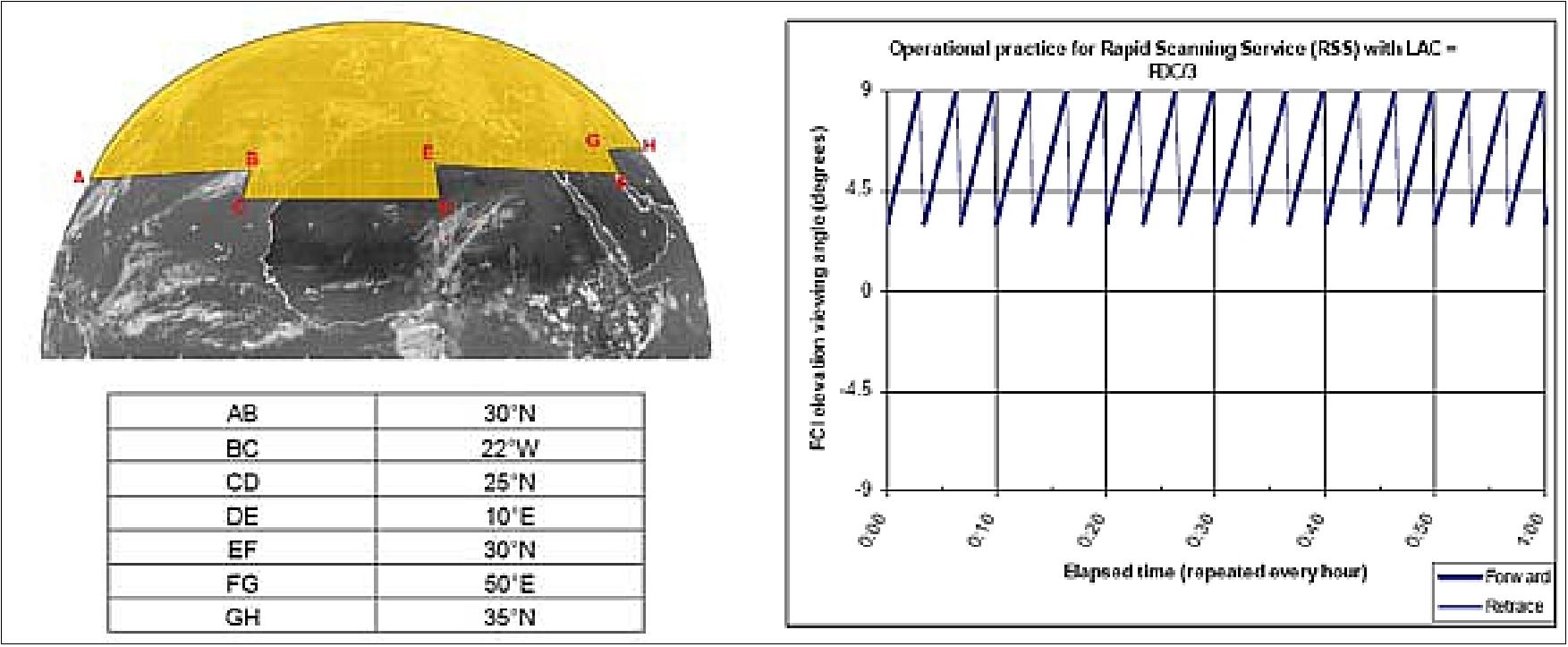
Earth coverage and temporal registration
A major characteristic of the instrument is its flexibility, allowing it to be used in several mission scenario. The nominal scenario is the FDC (Full Disk Coverage), which consists in a full Earth scanning in less than 10 minutes. Alternatively, it is possible to perform only a local area coverage (LAC scenario). For instance, by imaging only the North quarter of the Earth , the duration of the repeat cycle is then proportionally reduced to 2.5 minutes only.
The time needed to perform a complete East-West scan swath at the equator is lower than 10 seconds. This means that any two adjacent spatial samples in the image are very well temporally registered, even if they belong to two successive scan swaths.
Finally, any single point within the coverage zone can be acquired by all the 16 spectral channels in less than 0.3 seconds, thanks to a limited in-field separation of the spectral channels. This insures a high level of inter-channel temporal registration.
One of the challenging requirements of the MTG-I remains the ICRA (Inter-Channel Co-registration Accuracy). The contributors to the ICRA characterization include at instrument level:
- Detectors (spatial response uniformity of each pixel, pitch uniformity, dispersion and alignment)
- Optics (relay optics magnification, field distortion, alignment, stray light)
- Scan mechanism (actual scan rate and direction, scan rate stability)
- Integration (alignment)
- Satellite (launch stability, thermal stability, ageing, pointing stability in terms of drift and micro- vibrations, master-clock jitter).
FCI instrument: The FCI instrument is composed of the following elements Ref. 21):
• FCI-TA (Flexible Combined Imager-Telescope Assembly). TAS is prime contractor for the instrument, Kayser Threde is responsible for the procurement of the FCI-TA:
• The SSA (Spectral Separation & Detection Assembly)
• The FCI Electronics.
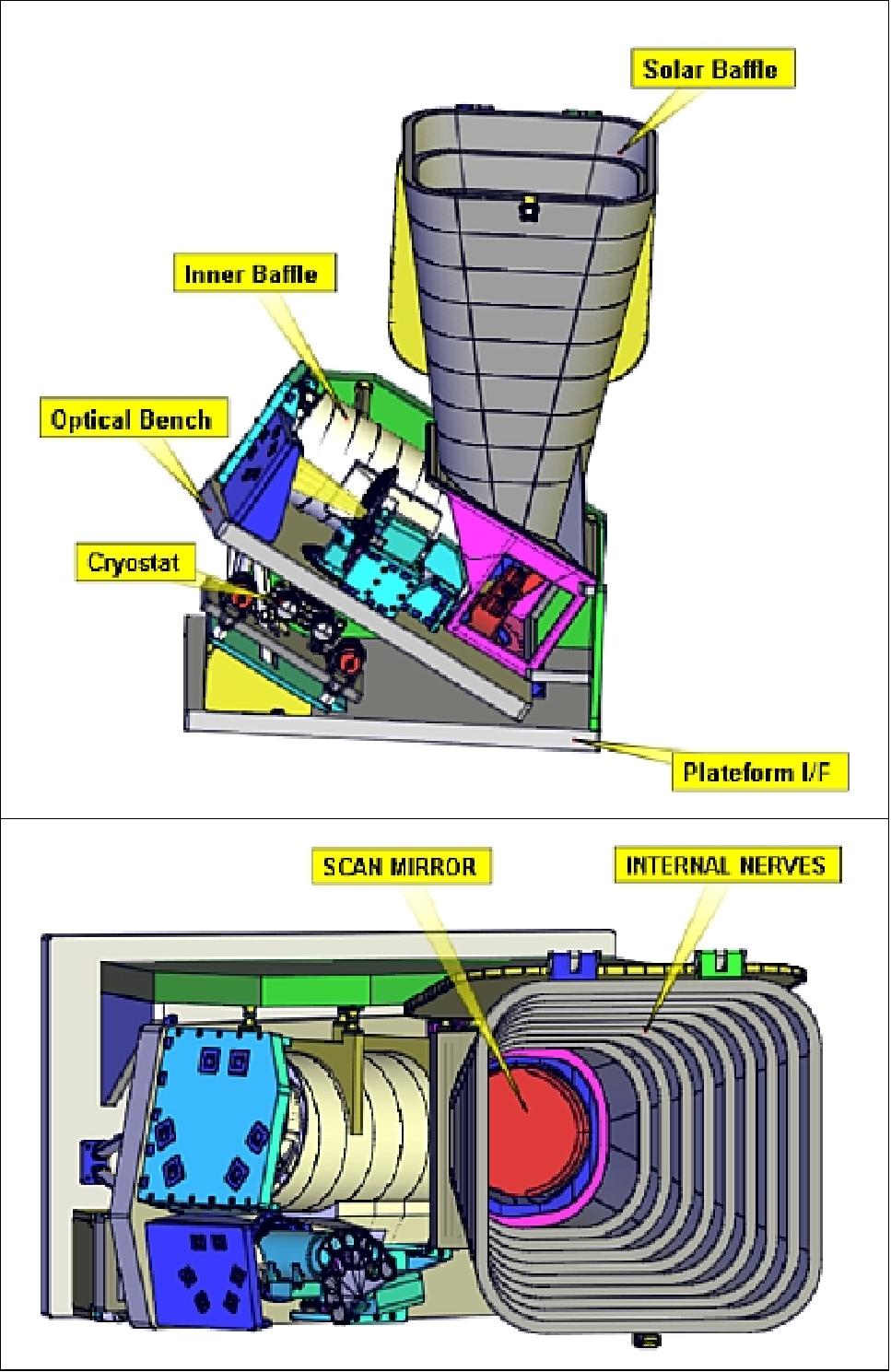
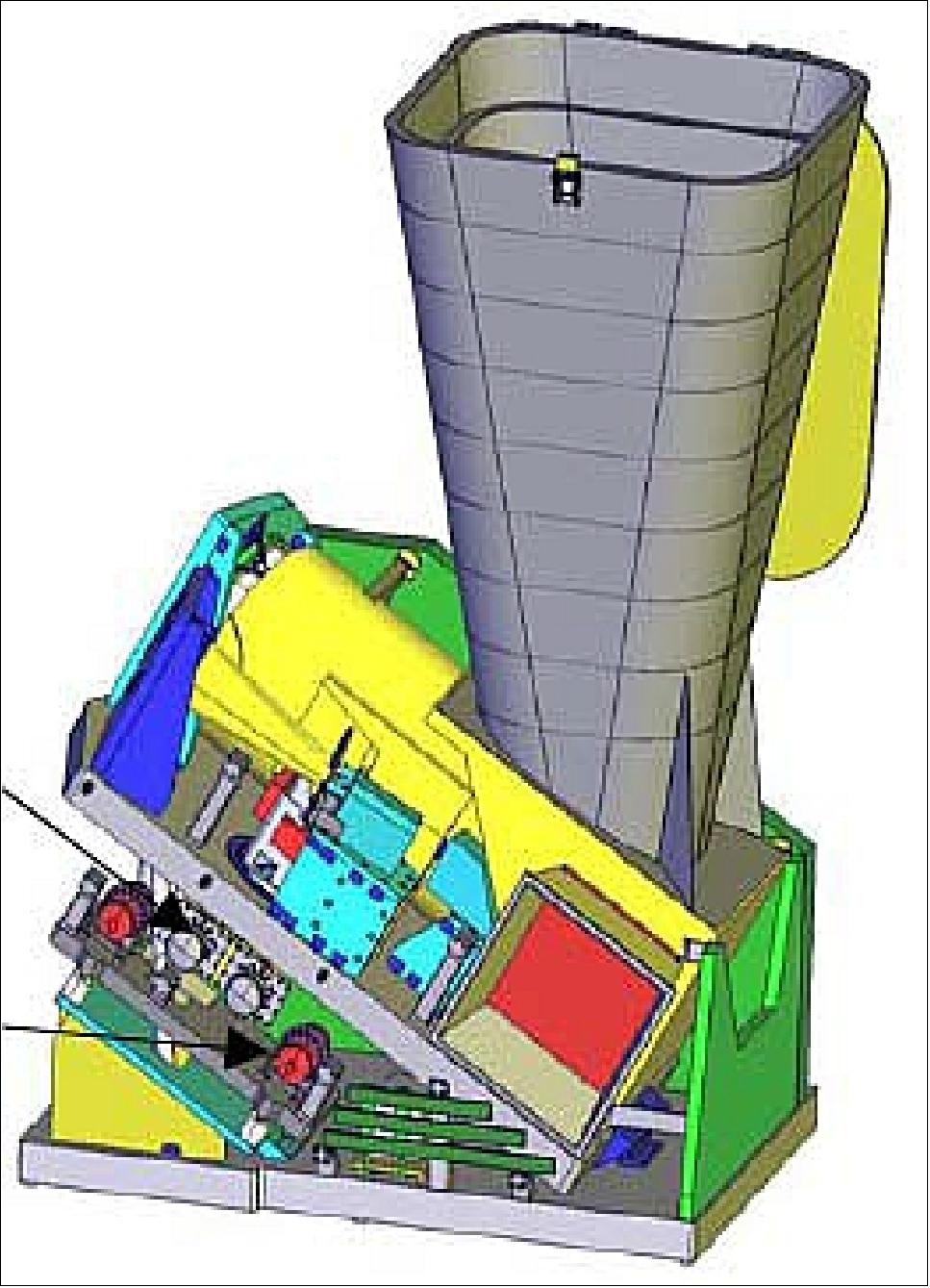
FCI optical design
Table 5 gives the optical characteristics of the instrument, as a result of the missions needs.
Parameter | VIS | NIR | IR1 | IR2 | IR3 |
Paraxial focal length (mm) | 1650 | 895 | 450 | 450 | 450 |
Entrance pupil diameter (mm) | 300 | 300 | 300 | 300 | 300 |
IFOV: N/S x E/W (º) | 0.40 x 0.40 | 0.40 x 0.40 | 0.40 x 0.74 | 0.40 x 0.74 | 0.40 x 0.74 |
Scanning mirror: The telescope includes a double-gimballed flat mirror called M0 that scans the full Earth disk. The entrance pupil of the instrument is located on this mirror, in order to minimize its size. At nadir, the average incident angle of the optical beam on the mirror is equal to 30°. This architecture choice was the result of the need to minimize the polarization ratio induced by the reflective coatings at high incidence angles. Figure 25 shows a view of the optical bench assembly with the telescope and the scan mirror. The scan mirror is developed by REOSC, St. Pierre du Perray, France.
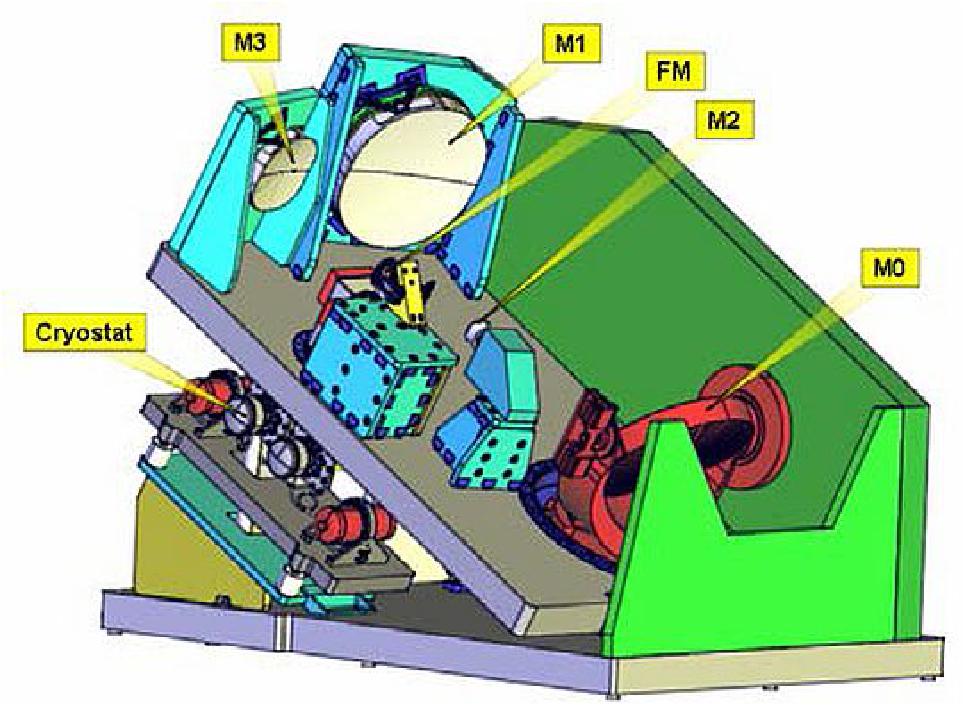
TMA telescope: After being reflected by the scan mirror, the light reaches a TMA (Three-Mirror Anastigmat) telescope. The characteristics of the mirrors are summarized in Table 6. The end-of-life WFE of the telescope, including the scan mirror M0, will be less than 80 nm rms over the whole FOV. The telescope has an off-axis angle of 1.4° and the mirror surfaces are aspheric in order to optimize image quality.
Parameter | M1 | M2 | M3 | M4 |
Radius of curvature (mm) | 1361.12 | 357.40 | 515.88 | Infinity |
Conic constant | -0.8763 | -6.092 | -0.2118 | N/A |
Optical clear aperture diameter (mm) | 335 | 60 | 175 | 68 |
The mirrors substrate will be Zerodur (except M0 in SiC), which exhibits a very low thermoelastic deformation. This is needed in order to avoid line of sight drift due to solar illumination. In order to reduce the mass, a light weighting will be applied on the rear face of the mirrors. All the mirrors will have a space qualified silver protected coating, which provides excellent transmission characteristics and good thermal behavior. The fixation on the optical bench will be insured thanks to Invar Mirror Fixation Devices (MFD) glued on the mirror side, as illustrated in Figure 26. These MFD will allow to filter out the deformation brought by the structure. The equipped mirrors will be developed by Thales-SESO.
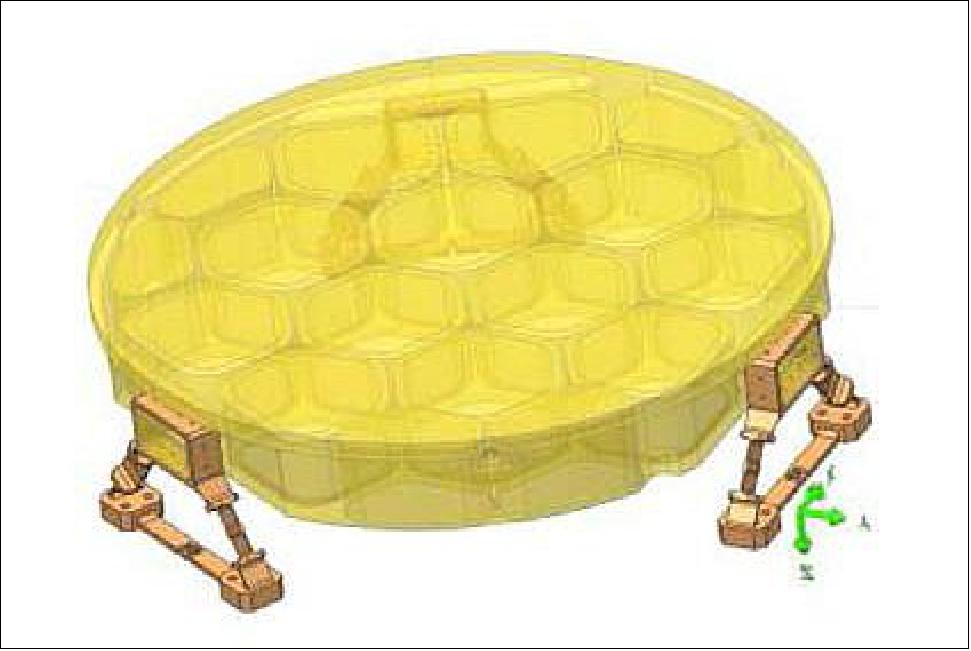
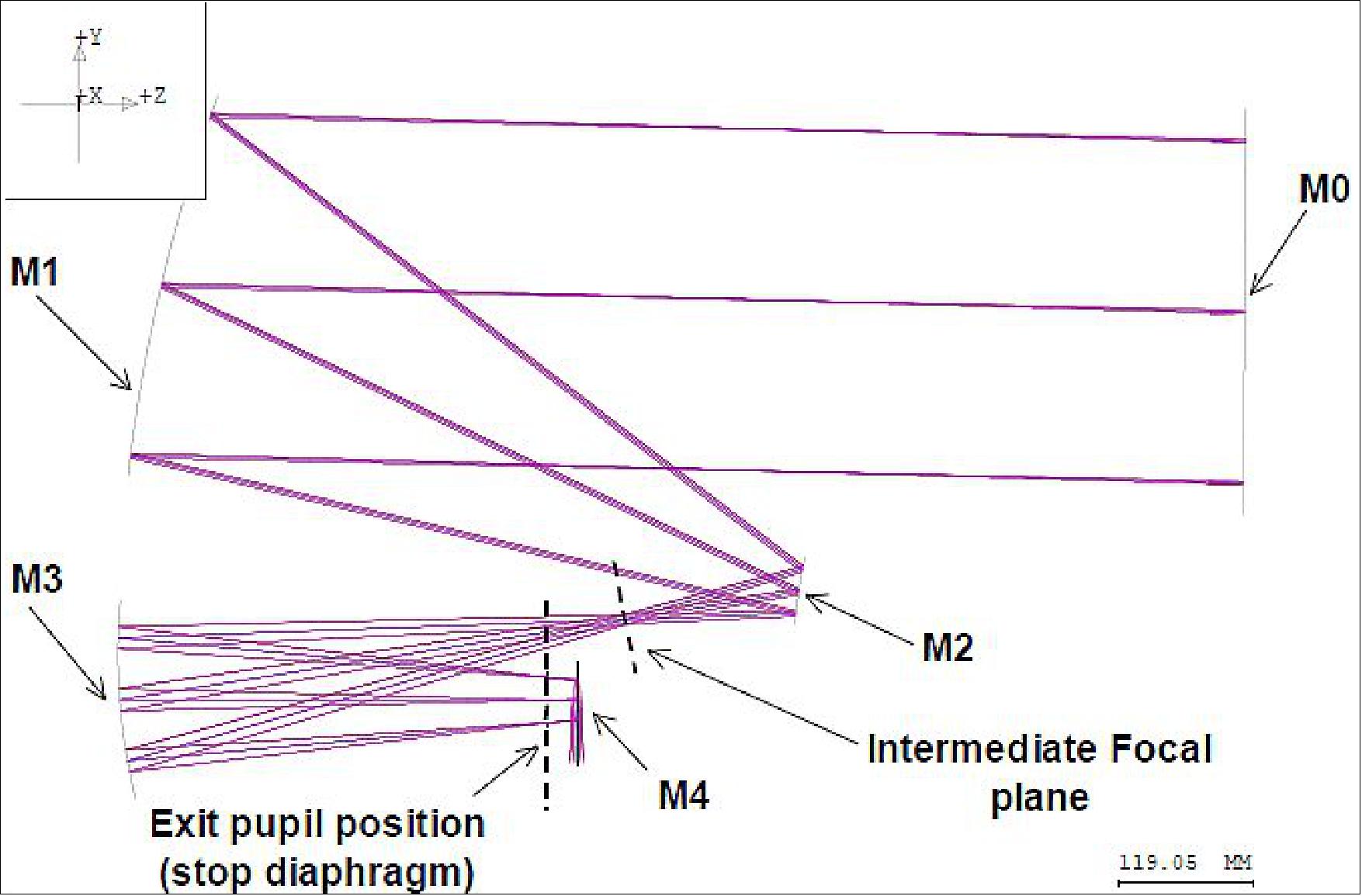
Baffles: Several types of baffles are implemented in the telescope structure in order to optimize the straylight rejection:
• An entrance solar baffle, whose aperture angle is limited by the need to scan the full Earth to a value about 10°. Its rejection angle is about 20°.
• An inner baffle which protects the entrance cavity from scan mirror M0 to M2, as illustrated in the Figure 26.

• The VIS and NIR calibration is performed by imaging the Sun through a MND (Metallic Neutral Density) inserted in the exit pupil of the instrument. Any spatial inhomogeneity of the density will then be completely averaged out in the focal plane. This component will be made out of fused silica, a material known for being insensitive to radiation, so that its transmittance will remain constant until the instrument end-of-life.
• The IR channel calibration is performed thanks to an embedded flat black-body inserted close to the intermediate image, in order to reduce its size and obtain the best thermal homogeneity. The black body is slightly out of focus to average out any spatial defect.
Both the black-body and MND are carried on a calibration wheel mounted on the optical bench. The mechanism wheel inserts those components in the optical path during calibration mode, as illustrated below. These calibration are performed without interruption the image acquisitions.
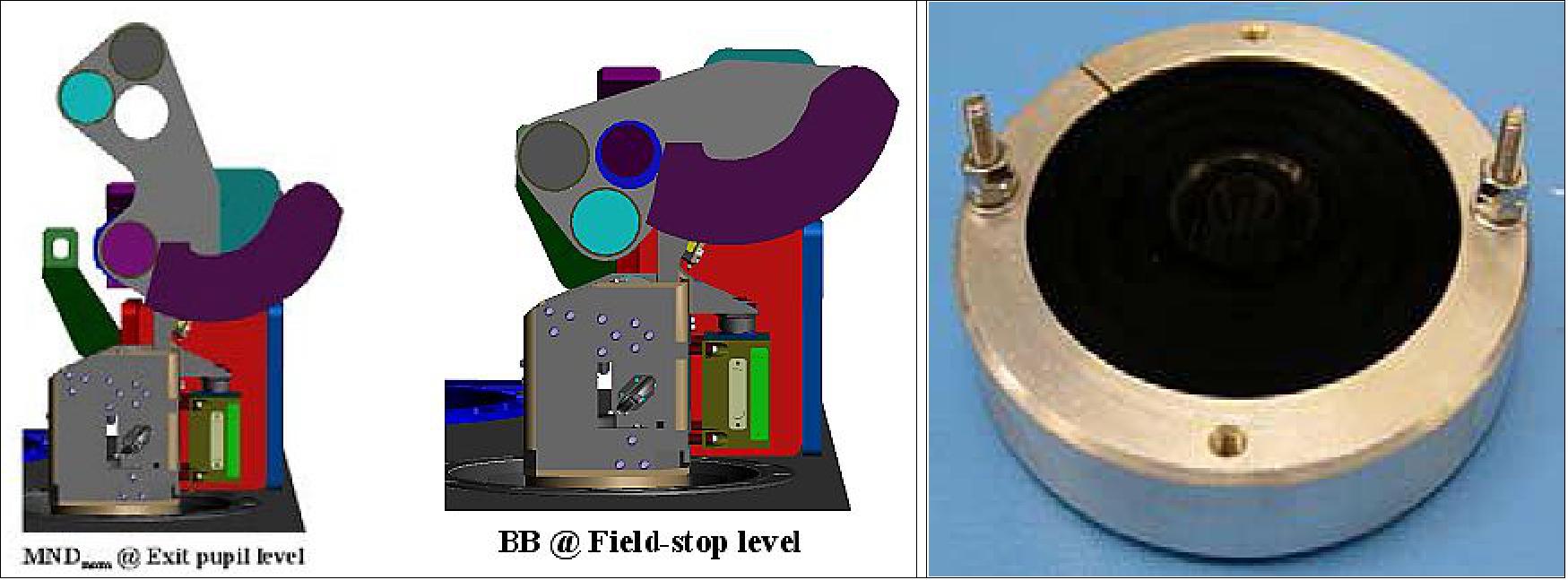
SSA (Spectral Separation Assembly): The main function of SSA is to separate the optical focused beam coming from the telescope into 5 spectral groups.
• VIS : without changing the focal length of the telescope.
• NIR, IR1, IR2, and IR3 : by collimating the 4 output beams, and adapting the magnification ratio in order to achieve the required instrument focal length for each channel.
For that purpose, the SSA will be composed of the following elements, mounted in a very stable Titanium housing:
• Dichroic beam-splitters, whose function is to separate the spectral groups
• Folding mirrors in order to geometrically separate the 4 collimated NIR/IR optical beams at SSA output
• And lenses in order to collimate the beams. This collimation allows to relax the integration tolerances between the SSA and the cold optics.
The SSA will exhibit an end-of-life WFE in the range of 100 - 200 nm rms depending on the spectral group. The SSA will be mounted on the OBA optical bench, and is illustrated in Figure 27. The SSA is developed by REOSC.
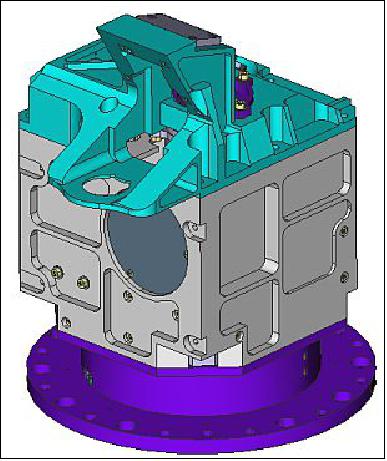
Cold optics: After being spectrally separated and collimated, the NIR/IR optical beams reach the cold optics, which are located inside a common cryostat. When entering the cryostat, the beams first go through an anti-contamination window (ACW) that prevents external molecular contaminants from condensing on cold parts. In order to avoid vignetting, the exit pupil of the SSA is coincident with cold diaphragms on top of the cold optics housings. These cold diaphragms limit the thermal IR background flux received by the detectors. There are 4 cold optics housings, one for each spectral group, which are made out of Titanium alloy. The lenses are in classical IR materials such as mono-crystalline Germanium, fused silica, ZnS and ZnSe. The cold optics will be operating at a temperature about 80 K with their full performances. The cold optics are developed by Thales-SESO.
The integration principle will be quite straight-forward, thanks to tight manufacturing tolerance, and an accurate positioning by pinning both the cold optics and the detectors on the cold plate, in order to ensure a good registration.
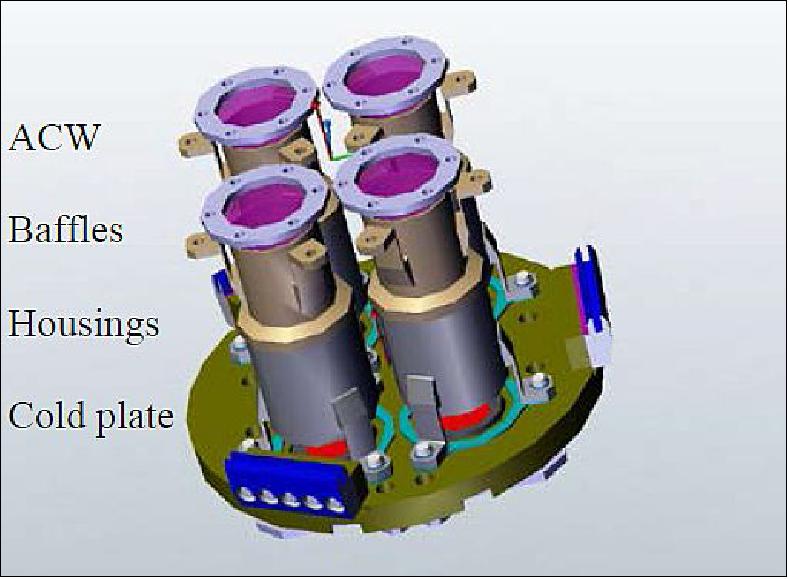
Detector package: Finally, before reaching the detectors, the optical beam goes through spectral filters. There are two kinds of detectors :
• The VIS detector, operating at ambient, is mounted directly on the SSA housing
• The NIR/IR detectors, operating at 60 K for radiometric performances, are mounted inside the common cryostat.
Those filters use the state-of-the-art technologies in terms of dielectric coatings. Blocking coatings on the rear face of the filters will allow to achieve the stringent out-of-band rejection requirement of 1%. The NIR/IR filters have been manufactured by REOSC, and the VIS filters by Jena-Optronik.
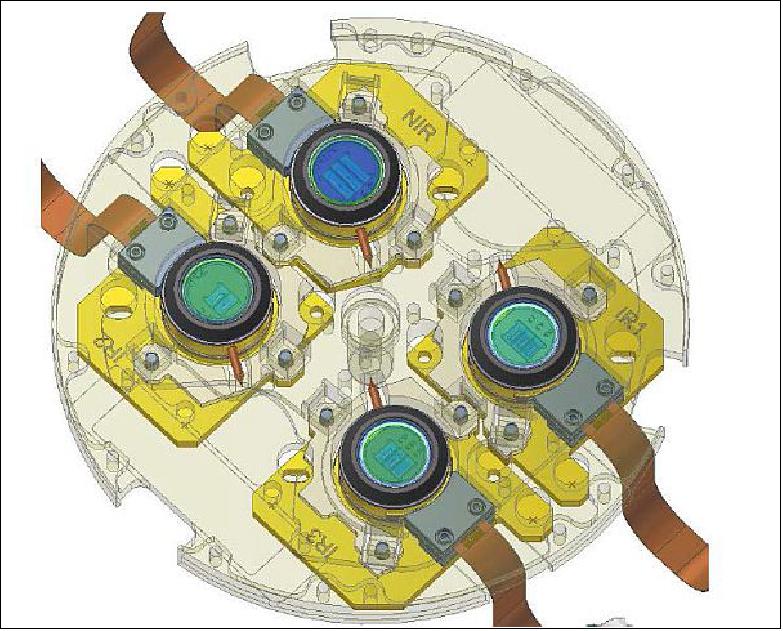
The FCI instrument accommodation parameters are : (Ref. 40)
• Volume: 1.57 m x 1.72 m x 2.2 m
• Mass: < 394 kg
• Power: < 495 W (max)
• Data rate: < 68 Mbit/s.
LI (Lightning Imager)
The overall objective of the LI system is to deliver on a continuous basis information on total lightning over the full disk (high timeliness, data quality homogeneity in time and space), allowing to extend “locally developed” algorithms for NWC (National Weather Center) severe weather warning to be applied over wider areas like Europe or the full Earth Disk. - LI has no heritage in Europe. Two USA LEO missions (LIS and OTD) have already flown and one, the GML (Global Lightning Mapper) of GOES-R, is scheduled for launch in November 2016. 45)
• The LI measurements of total lightning [IC (Intra Cloud)+CG (Cloud Ground)] are complementing the global measurements of CG lightning as provided by ground based systems and will improve the quality of information which is essential for air traffic routing and safety.
• The information on IC+CG will allow to assess the impact of climate change on thunderstorm activity by monitoring and long-term analyzing lightning characteristics – in cooperation with the two NOAA GLMs on GOES-R and GOES-S - a major part of the globe is covered by a long term committed GEO lightning (IC+GC) observing system.
• Providing IC+CG information on a global scale will be a prerequisite for studying and monitoring the physical and chemical processes in the atmosphere regarding NOx, playing a key role in the ozone conversion process and acid rain generation.
• Error characterized IC+CG information can be assimilated to improve very short range forecasts of severe convective events or used to verify/validate other satellite data based NWC algorithms to forecast time and location of initiation of lightning.
The LI system is conceived for the detection of lightning in Earth's atmosphere from a geostationary orbit, where the FOV (Field of View) of Earth's full disk extents to an angle of 17.5º. The basic LI observation concept is to cover this FOV with four lenses and four detectors, each one covering a square FOV of 8.7º x 8.7º, corresponding to 12.3º diagonal FOV, in order to reduce the incidence angle on the interferential filter placed on the pupil of each subsystem. An important advantage in splitting the interference filter in four parts is related to the possibility to reduce its dimensions and to ease its manufacturing. 46) 47) 48)
TAS (Thales Alenia Space) as the MTG prime contractor is responsible for the procurement of the LI (Lightning Imager) instrument developed and manufactured by Selex Galileo of Campi Bisenzio, Italy, a Finmeccanica company. 49) 50) 51)
FOV (Field of View) | 16º Ø shifted northward or 84% of visible Earth disk, including all EUMETSAT member states |
Spatial sampling | < 10 km @ latitude 45º and subsatellite longitude |
Dynamic range of Earth background (Lbkg) | 0 - 296.5 W/m2/µm/sr (night ÷ summer solstice at midday) |
Optical pulse dynamic range (LLp) | 6.7 - 670 mW/m2/sr |
Optical pulse spectral range | 777.4 ± 0.17 nm |
Minimum optical pulse duration | 0.6 ms |
Optical pulse size | 10 km - 100 km circular pulse diameter |
Maximum number of optical pulses in the FOV | 25 in 1 millisecond |
IADP (Instrument Average detection probability) | 90% for latitude 45º, 70% as average over the FOV, 40% over EUMETSAT member states (goal) |
LI mass (total optical head and electronics box) | 93 kg |
LI optical head envelope | 718 mm x 1200 mm x 1456 mm |
The instrument works in a staring mode, detecting lightning events within its FOV of its 4 cameras. The lightning detection is achieved implementing the following functions:
• Earth image acquisition for continuous monitoring of the lightning’s presence in the FOV; the image spectral bandwidth is reduced by an optical filter to the range of the lightning spectral pulse (Figure 30)
• Calculation of pixel by pixel adaptive background to cope with non-uniformities and low terms variations of the image (oceans, clouds, area in night conditions and areas with daylight conditions) and to reject at the same time noise effects and spurious events
• Removal of the background level from the overall pixel signal to obtain the net lightning illumination level
• Use of adaptive threshold; lower thresholds can be used in low noise dark areas of the scene, using higher thresholds only in highly illuminated areas (with corresponding higher shot noise)
• Pixels for which the difference between the pixel value and the estimated background signal exceeds the threshold are kept as DTs (Detected Transients)
• Collection of the DT video data and additional information for the ground processing with a dedicated processing electronics
• In flight processing of DTs to reduce the number of FT (False Transients) to a level compatible with the platform downlink data rate constraints (30 Mbit/s).
In addition LI is capable to acquire, process and transmit to the ground an Earth background image.
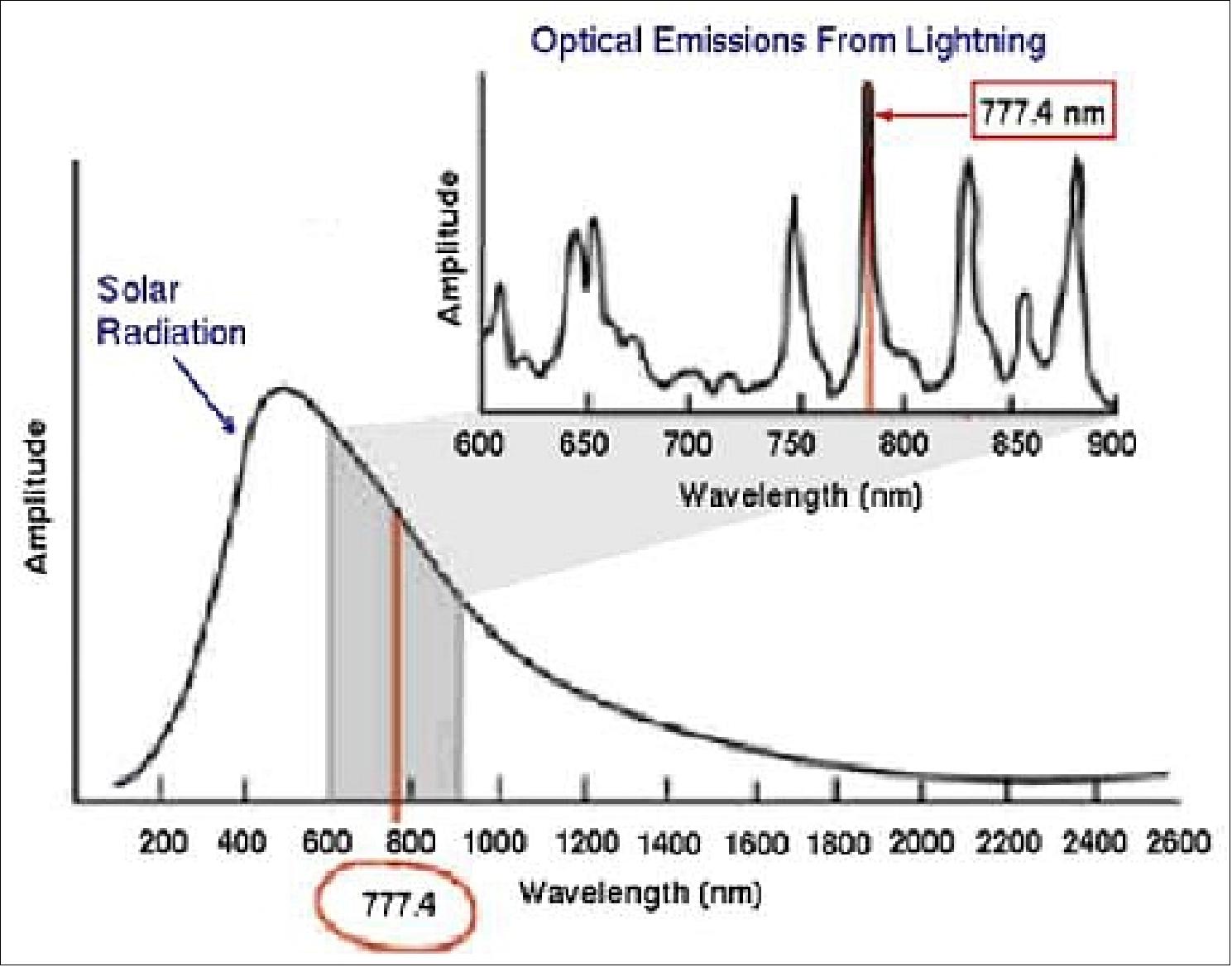
Instrument overview: LI is composed of one LOH (LI Optical Head) and one electronics unit, the LME (LI Main Electronics). The LOH consists of four identical OCs (Optical Channels), each one including (Figure 34):
• a protective cover on the baffle aperture to prevent baffle and optics contamination during launch and prelaunch activities
• a baffle for stray light suppression and thermal load minimization
• a SRF (Solar Rejection Filter), to minimize both the background level and the thermal load inside the OC
• a NBF (Narrow Band Filter) to reduce the bandwidth in the range of the lightning spectral pulse (Figure 30)
• an optical system with F# 1.73, 110 mm entrance pupil diameter (determined by radiometry required to achieve the IADP performance) and 190 mm effective focal length [determined by the targeted GSD of 4.5 km at SSP (Sub Satellite Point) and the size of detector pixels]
• a CMOS detector with 1000 x 1170 pixels, 24 µm pitch, 1000 frame/s 52)
• a processing electronics device implementing the detection functions.
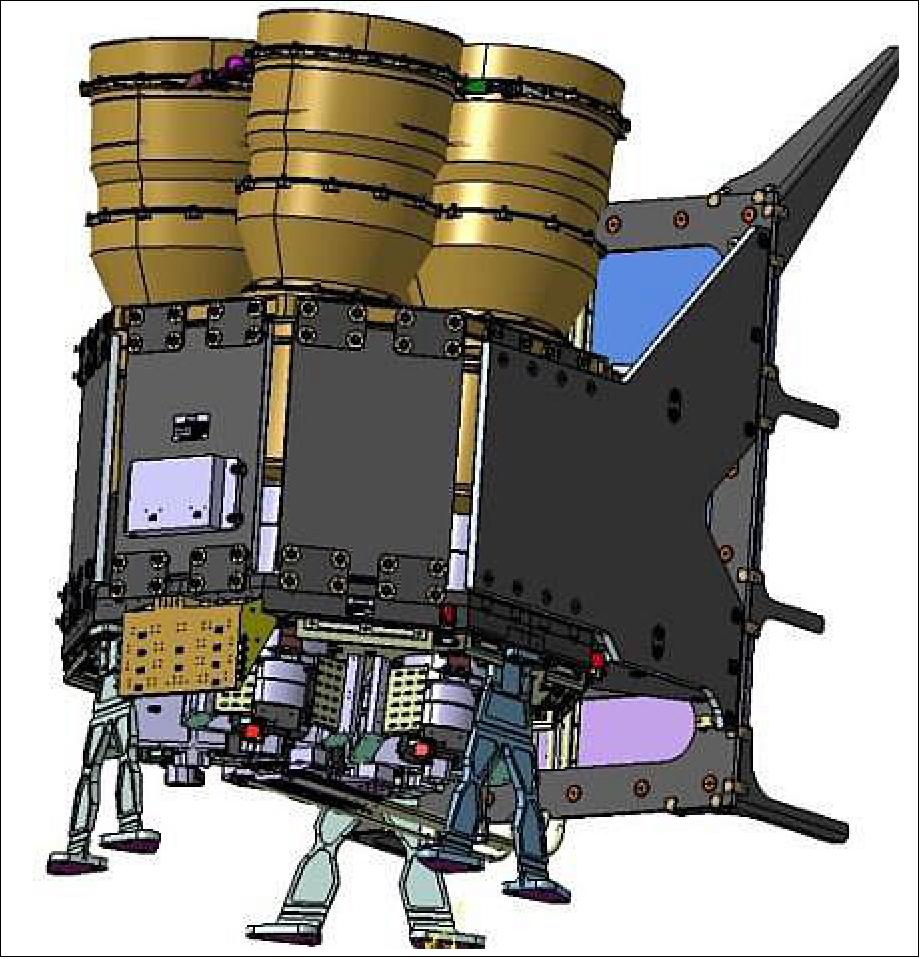
Each OC images a different portion of the visible Earth surface with the four line of sights tilted 4.75° from the SSP toward North, South, West and East in order to achieve the required coverage (Figure 35).
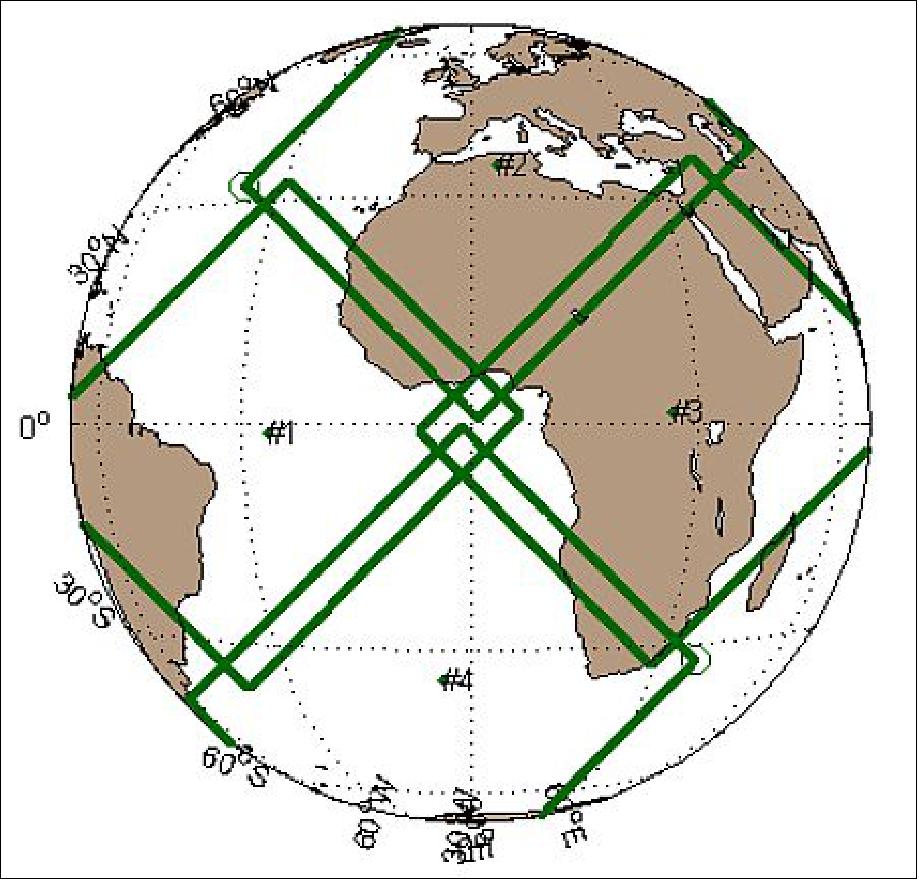
The LME (LI Main Electronics) performs the overall payload functions, the interface to the platform, the configuration of the processing electronics, the data flow regulation, and finally compacts and packetizes the scientific data. The LME consists of the Power Units and the Single Board Computer. This first European processing board, implementing a “Power PC” technology (PPC7448 with 2300 DMIPS @ 1GHz), allows managing the Application Software that implements the algorithm of the microvibration filter (to reduce the number of FTs due to microvibrations) and the algorithm for data regulation implemented to prevent the instrument from saturation of internal interfaces and memory buffers.
Optical Design and Spectral Filters
The optical system of each Optical Channel is composed of 5 lenses and two spectral filters: a SRW (Solar Rejection Window) and a NBF (Narrow Band Filter). The SRW is the first optical element, placed close to the baffle. It is devoted to reflect the solar radiation and to work in synergy with NBF to obtain the required spectral filtering.
The NBF performs the spectral discrimination of the lightning pulse from the Earth background radiance. Since the spectral response of an interferential filter is a function of the AOI (and the filter equivalent refractive index), the NBF has to be placed where, in the optical system, the beam slant is smaller. The LOH multi-channel approach reduces the FOV of each optical system allowing an advantageous placing of the NBF in front of the lens so that the beams are parallel and the filter AOI (Angle of Incidence) coincides with the FOV.
The driver of the optical design are the narrow wavelength range and the 90% ensquared energy requirement on a 25°C thermal range, guaranteed by the OTC (Operational Thermal Control) system.
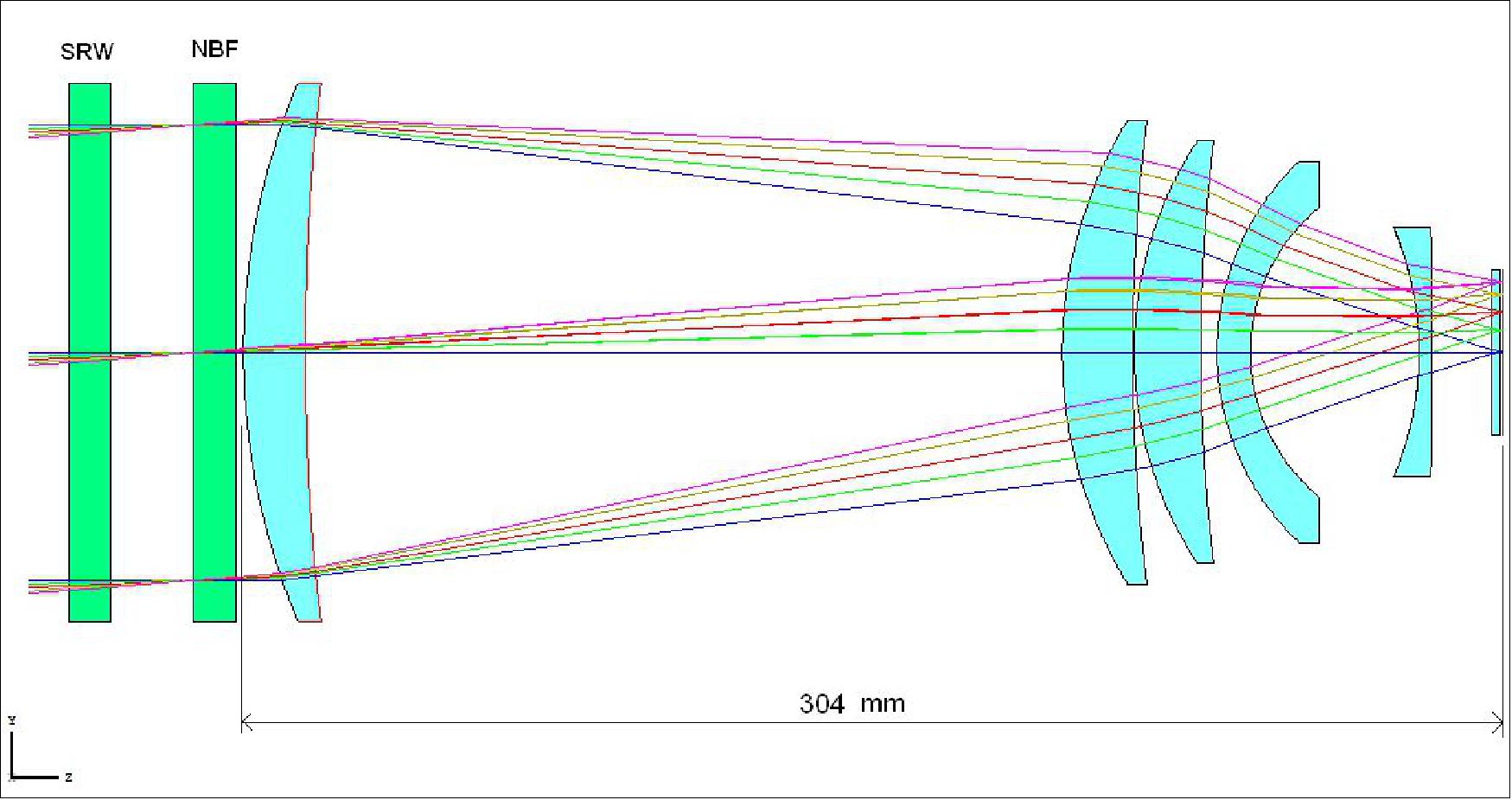
Effective focal length | 190.8 mm |
Entrance pupil diameter | 110 mm |
Entrance pupil position | on the NBF filter |
FOV (Field of View) | 5.1º |
Transparency (including filters) | >80% |
Wavelength range | 777.15 - 777.75 nm |
Max vignetting | 0 |
Thermal operating range | 15 to 40ºC |
Maximum distortion | 0.07% |
Optical Head thermo-mechanical design
The skeleton of the OH consists of a Structure made of composite material. In its lower part the structure is conceived as a baseplate with monolithic sandwich structure, supporting the four telescopes which compose the optical system of the LI instrument and interfacing the satellite Earth deck by means of three bipods, resulting in a quasi-isostatic mounting. This solution guarantees:
• Compromise between mass and stiffness-strength (low mass/stiffness-strength ratio)
• Thermo-elastic compatibility, matching the CTEs (Coefficient of Thermal Expansion) with the underneath satellite structure, aiming to the maximum reduction of mutually induced thermal stresses and then distortions.
In its upper part the structure hosts the aluminum plate where the four baffles are linked to; this includes also the SRW for thermal reasons.
In its bottom side the Structure brings the thermal system, composed by the radiators and heat pipes for the thermal control of the instrument, such to guarantee the proper heat rejection for internally generated heat, and the maintaining of the required temperature levels during mission phases. The entire LOH (LI Optical Head) is enclosed in a MLI (Multi-Layered Insulation) blanket, providing thermal shielding towards the external irradiative environment.
The optical barrels consist of cylindrically shaped housing structures in Titanium alloy, inside which the optical elements (lenses, NBFs) are mounted.
The FPAs (Focal Plane Arrays), containing the DUs, are mounted on the bottom of the barrels by means of an isolating system: this will also allow enhancing thermal stability of the optical system when temperature isothermally changes.
The FEE (Front End Electronics) is accommodated close to the FPA, for signal integrity reasons. The functional connection between FPA and FEE is provided by PCB Flex elements.
The LOH thermal design is devoted to the maintenance of the minimum temperatures for all items during the instrument Safe and Survival mode and to the fulfilment of the performance operative temperature range during the nominal Operational mode. The thermal design has to cope with the dissipation of four FPAs and four FEEs for a total of about 110W, in addition to orbital heat fluxes directly incoming in each baffle and SRW and external MLI. The heat transport toward the radiator is obtained by means of a cold plate and a redundant heat pipe.
Two cavities can be identified in the design, dedicated to thermal and thermo-elastic stabilization of the relevant hardware: one FPA cavity and one optical channels cavity.
In addition to passive elements, the thermal design includes active thermal hardware for OTC and STC. The OTC is devoted to the temperature stabilization of LOH internal items in order to meet the functional and pointing stability requirements and is based on 13 heater lines individually controlled by means of thermistors and drivers located inside LME PU (Power Unit). The STC (Survival Thermal Control) is composed by 8 heater lines individually controlled by means of thermistors and electronic thermostats located inside STC box in the LOH, directly powered by the platform when LI and OTC are switched OFF.
DU (Detector Unit)
The DU is a key element of the LI design as many of the system requirements are dependent on its characteristics and performance. It is a backside illuminated CMOS APS (Active Pixel Sensor) detector with the architecture of Figure 37 and the characteristics reported in Table 8. The backside illuminated technology improves the QE (Quantum Efficiency) and consequently the SNR required by the detection process.
The DU has internal column ADCs (Analog Digital Converters) allowing digitization of 5 rows in parallel, providing the necessary processing capacity to operate at 1 kHz frame rate. Digital data are then multiplexed internally to the serial LVDS (Low Voltage Differential Signaling) outputs running at 250 Mbit/s.
Format, pixel | 1000 x1170, 24 µm |
Digital outputs | 60 @ 250 Mbit/s |
ADC (Analog Digital Conversion) resolution | 12 bit |
Full well | 450.000 e- |
Global QE | > 0.7 |
MTF @ Nyquist | > 0.55 |
Frame rate | 1 kHz |
Noise in darkness | < 150 e- |
PRNU (Photo Response Non-Uniformity) | < 3% |
Dark current | < 66.000 e-/s |
Nominal temperature | 20ºC |
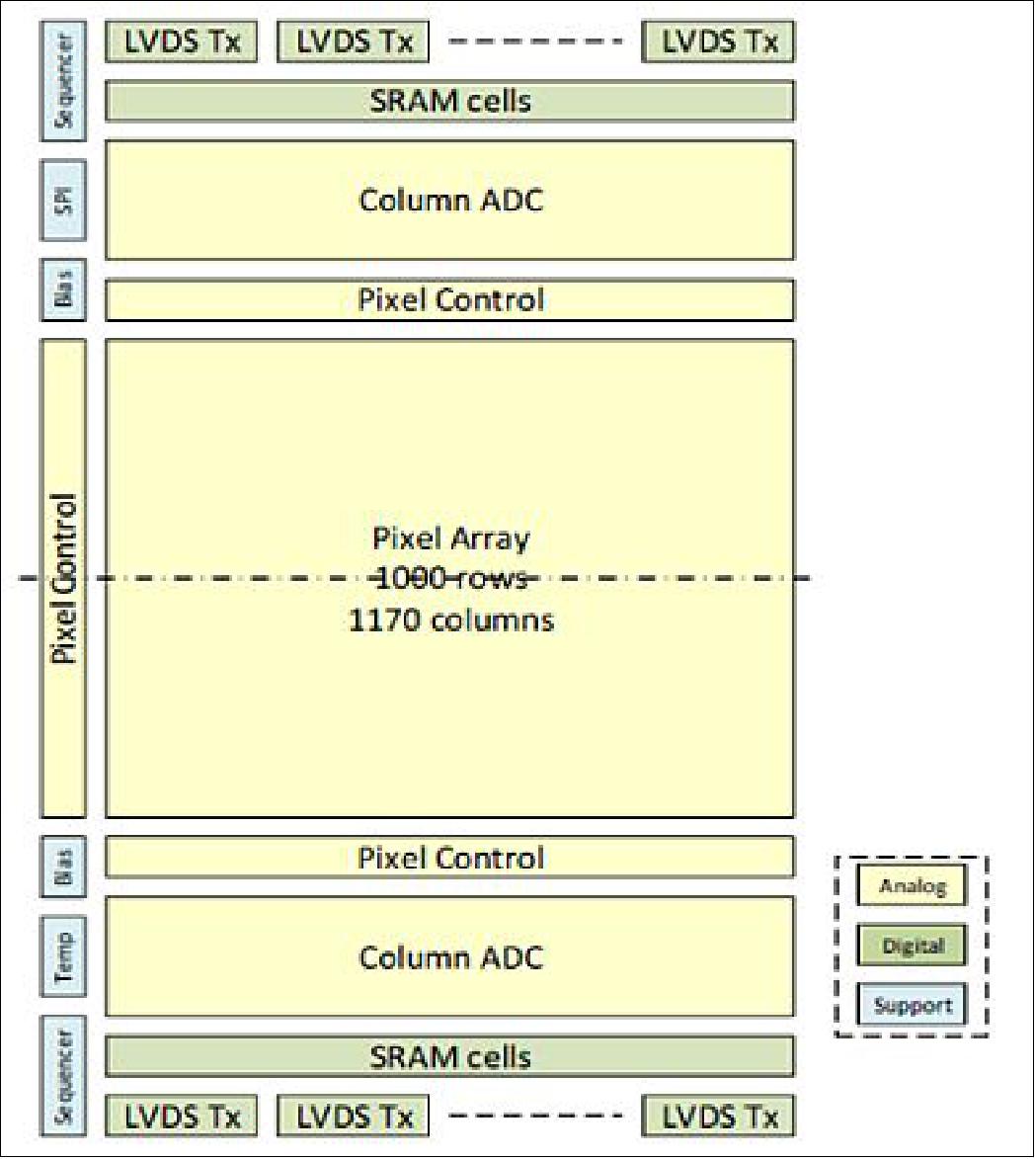
On-board Processing
The on-board processing detection architecture is composed by two three main blocks: RTPP (Real Time Pixel Processor), SDTF (Single DT Filter) stage, and MVF (Micro-Vibrations Filter) stage. The RTPP interfaces the digital outputs of the DU, reading the pixel outputs and identifying DTs (Detected Transients).
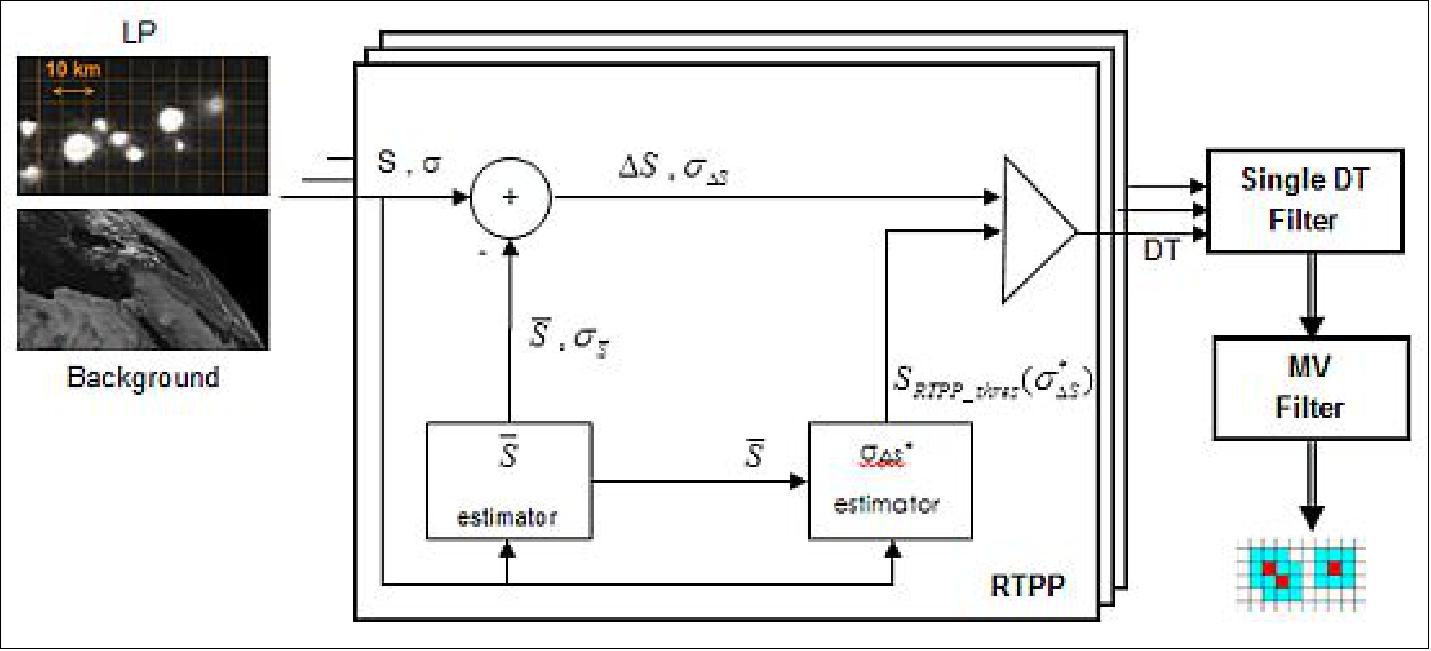
The lighting event elementary detection process mainly consists of the following tasks, based on time-domain filtering, performed on each pixel independently by the RTPP stage:
- reference background estimation for thresholding
- subtraction of estimated background from current pixel signal
- threshold calculation/optimization, based on estimated background noise
- thresholding of differential signal
- encoding of triggered event position within the DU array
- triggered event radiometric data collection.
The RTPP threshold selected for each pixel is adapted to the current estimated background level of the pixel itself. At each frame (typically 1ms frame rate), the radiometric data of the 3 x 3 window surrounding the pixels which are revealed as Detected Transients are collected and sent to the next stage of on-board processing.
The SDTF is a filter implemented in order to reduce the FT rate per frame, mainly generated by temporal noise affecting the background acquisition. It is based on the integration of the signal in the 3 x 3 pixels window surrounding the DT, where, in case of false detection of the central pixel, neighbor pixels do not bring information (uncorrelated noise).
In case a DT is confirmed by the SDTF, its relevant 3 x 3 window is then passed into the MVF stage, which is a filter designed in order to reduce the number of FTs due to microvibrations. The radiometric characteristics of the background of the 3 x 3 pixels surrounding the DT allows to implement a classification algorithm, which applies an adaptive threshold based on the estimated tuples of background radiance/gradients.
If the latter threshold is passed, the DT is confirmed for the pixel and the 3x3 window data is transmitted to Platform and then to ground, where additional filtering stages are applied in the L1b processor for further classifying its possible FT nature.
Both RTPP and SDTF stages are implemented in the FEE of each OC (Optical Channel).
Due to the high amount of pixels (each DU array is 1170 x 1000 pixels) and to the high frame rate, 60 independent RTPPs are implemented in 4 ASICs to work in parallel over each DU. Moreover, due to the high amount of data generated by the optimal threshold settings (needed to maximize the detection efficiency in a very noisy environment), four SDTF filters are implemented in parallel in an FPGA, managing the data coming from each ASIC. The implementation of processing in ASICs/FPGA, with relevant input/output buffers, internal RAM and high speed bus, allows to strongly reduce the bottlenecks in the FEE, which provides a very high data throughput capability.
The MVF and Data Regulation algorithms are implemented in the SW of the LME.
Calibration
The LI does not have an in-flight calibration unit, thus the temporally continuous acquisitions performed by the instrument will be exploited, together with vicarious calibration techniques and dark acquisitions, in order to monitor the instrument through time, detect degradation of its components to some degree and to be able to perform in-flight calibration, within the required accuracy of 10% for both background and lightning pulse radiance samples.
A set of radiometric calibration parameters , KDPs (Key Data Parameters), has been identified and introduced in the on-ground L1b Radiometric Processor, in order to retrieve the spectral radiance of background samples and the radiance of the lightning pulse samples. All the KDPs, together with a set of characterization parameters, will be calibrated during on-ground phase for each Optical Channel. Only of a subset of them will be updated in-flight, according to Table 10.
Method | LI mode | Planning |
Dark acquisitions (offset and readout noise, dark signal, linearity) | CALIB | Periodical |
Vicarious calibration | OPER | Periodical |
TOA reflectance database (cloud mask) | OPER | Continuous |
Overlapping zones (DT, radiance) | OPER | Continuous |
Long term pixel DT statistics | OPER | Continuous |
Long term pixel temporal average (pixel gain) | OPER | Continuous |
Long term spatial average (common gain) | OPER | Continuous |
Moon observation (MTF) | OPER | Continuous |
Image Capture
The first images captured by the LI were released on 3 July 2023.
Below are two animations containing a sequence of images created by collecting one minute’s worth of lightning measurements, overlaid on a single image of Earth from the Lightning Imager.
While the animations are a first initial result from the Lightning Imager, the Meteosat Third Generation Imager is currently undergoing its commissioning phase during which the instruments are calibrated and the data is validated. Data from the Lightning Imager will be available for operational use in early-2024 at an increased sensitivity.
Access all the MTG Lightning Imager animations here.
IRS (Infrared Sounder)
The IRS (also referred to as GeoSounder) objectives are to provide “break through” measurements on the time evolution of horizontal and vertical water vapor structures ins the atmosphere – an unprecedented source of information available for the operational services in NWCs (National Weather Centers) and regional/global NWP (Numerical Weather Prediction). The IRS has no heritage instrument in previous Meteosat missions.
• The IRS (30 minute repeat cycle over Europe) will fill large spatial and temporal voids in the 12 hour time standard radiosonde observations and will allow time and space interpolation of moisture/temperature observations taken from the polar orbit.
• The IRS derived information on low tropospheric moisture and its changes in time is expected to lead to a better depiction of the hydrological cycle in models, potentially providing better precipitation forecasts.
• The IRS will provide information on vertically resolved atmospheric motion vectors with improved height assignment, which in particular is beneficial for the tropical areas having only a weak coupling between the dynamic and thermodynamic atmospheric fields.
• The IRS will provide information to identify pre-convective situations supporting NWC applications to forecast convective initiation.
• IRS will support forecasting pollution and monitoring of atmospheric minor constituents through its capability to provide estimates of diurnal variations of tropospheric contributions of atmospheric trace gases such as O3 and CO.
Band | Frequency range (cm-1) | Main constituents | Resolving power (@ center frequency) | NEDT @ 280 K | GSD (Ground Sampling Distance), km |
IRS-0 | 667-700 | CO2 | 1367 | TBD | 6 |
IRS-1 | 700-770 | CO2 | 1470 | 0.2 K | 6 |
IRS-2 | 770-980 | Surface, clouds | 1400 | 0.24 K | 6 |
IRS-3 | 980-1070 | O3 | 2070 | 0.2 K | 6 |
IRS-4 | 1070-1210 | Source, clouds | 1344 | 0.3 K | 6 |
IRS-5 | 1210-1600 | H2O, N2O, CH4 | 2248 | 0.2 K | 3 |
IRS-6 | 1600-2000 | H2O, NO | 2880 | 0.2 K | 3 |
IRS-7 | 2000-2250 | CO2, N2O | 3400 | 0.2 K | 3 |
IRS-8 | 2250-2400 | CO2 | 1860 | TBD | 3 |
IRS-9 | 2400-2500 | Surface, clouds, N2O | 1000 | TBD | 3 |
The IRS operates at millimeter wavelengths which are capable to penetrate clouds and rain. Its design relies on a principle called interferometry, with separate signals from multiple antennas correlated together to produce an image of otherwise impossible sharpness. To further reduce the number of antennas needed, the device rotates at 1º/s, filling in further detail.
Geostationary infrared sounding missions offer good temporal coverage, however due to the large distance to the observed targets on Earth, the effect of diffraction is increased compared to sounding from LEO (Low Earth Orbit). Due to the wavelength dependence of diffraction, the spectral channels do not sample the same volume of air, as in general assumed by the retrieval algorithms for LEO infrared sounder data. This additional error introduced in the retrieval by diffraction limited instruments is in general referred to as ‘pseudo noise.’ 53) 54) 55)
Contrary to infrared sounders in LEO, the main objective of the IRS (in GEO) is not absolute temperature/humidity sounding. Rather, the prime objective of IRS is to support the dynamics via tracking of vertical water vapor structures. The user of IRS data is mostly interested in the information on vertical structures (temperature, humidity and wind at high horizontal, vertical and temporal resolution), which comes from the fidelity of the spectral information. This fidelity would be destroyed by excessive and spectrally uncorrelated random noise. In case of a spectrally high correlated noise (spectral bias) the information on vertical structure is not equally destroyed, i.e. it will have a lesser impact.
The IRS data will contribute both through assimilation into convective-scale, regional and global NWP (Numerical Weather Prediction) models and through nowcasting products. The data will be particularly important for observing the advection and convergence of low-level moisture associated with some types of severe weather in Europe. The main goal is to document the added value of water vapor observations derived from a hyperspectral infrared sounding instrument on a geostationary satellite for regional forecasting.
Preliminary IRS instrument accommodation parameters are (Ref. 40) :
• Volume: 1.44 m x 1.30 m x 1.25 m
• Mass: ~470 kg
• Power: ~858 W
• Data rate: ~167 Mbit/s
The state-of-the-art IRS instrument is being developed by Kayser Threde of Munich, an OHB company. The objective of IRS is to probe the atmosphere and provide information on the horizontal, vertical and temporal resolution of water vapor and temperature distributions. 56)
The IRS instrument is designed to detect, with a high radiometric accuracy, the signals emitted from gases in the atmosphere. A demanding spectral resolution for velocity determination is used to determine the wind profiles at various heights above ground together with a high spatial and temporal resolution.
The instrument will be able to scan the full Earth circle within 1 hour with a spatial on ground resolution of 4 km x 4 km from geostationary orbitin two spectral bands (MWIR: 1600 to 2175cm-1 and LWIR: 700 to 1210cm-1) with a spectral resolution of 0.6 cm-1. This resolution can be achieved by means of a high resolution telescope operating in the infrared spectral range with a scan mirror assembly allowing a step and stare of the line of sight. Radiometric, spectral and geometric requirements are met both in nominal and restricted operations conditions. 57)
Among the critical technologies and processes, the IRS detection chain shall offer outstanding characteristics in terms of radiometric performance like SNR (Signal to Noise Ratio), dynamic range and linearity. Selected detectors are HgCdTe 2D arrays, cooled at 55 K, hybridized on snapshot silicon read-out circuit at 160 x 160 format. The video electronics provide a resolution of 16 bits, and the whole detection chain (detectors and electronics) permits to reach SNR between 2000 and 10000 as requested by the application.
The IRS instrument is a sounding Fourier transform spectrometer, which allows recomposing atmospheric spectrum after infrared photons detection. Transmission spectrums will be used to support numerical weather prediction. The IRS comprises the following main subsystems:
• The scan assembly allows performing a complete scan of the earth disk in a fully programmable scan pattern including stares to cold space for fast and repeated recalibration of the full optical path.
• The unique design of the entrance cavity allows the sun to enter the instrument through an entrance baffle together with an internal baffle thermally decoupled from sensitive elements like mirrors and optical bench.
• The front-telescope reduces the entrance pupil, located at the scan mirror to the back-telescope, by a factor of 4, while an in-built imager allows, via a small band beam splitter, a direct and parallel detection of the investigated ground area in the spectral band between visible and infrared.
• The Michelson interferometer generates the interferograms at each position of the scan assembly by highly accurate motion of a corner cube. At each observation position 2 x 25,600 interferograms are recorded simultaneously in two spectral bands, by two detector arrays. The detectors are integrated and co-aligned in order to achieve a high inter-band coregistration.
• The back-telescope is an in-size reduced afocal front-telescope to adapt the interferometer to the cold optics. Efficient straylight reduction is achieved by means of an intermediate field stop located in the front telescope before the interferometer. The cooling of the detectors and optics behind the back telescope, down to 55 K, is realized by means of two active cryocoolers for redundancy.
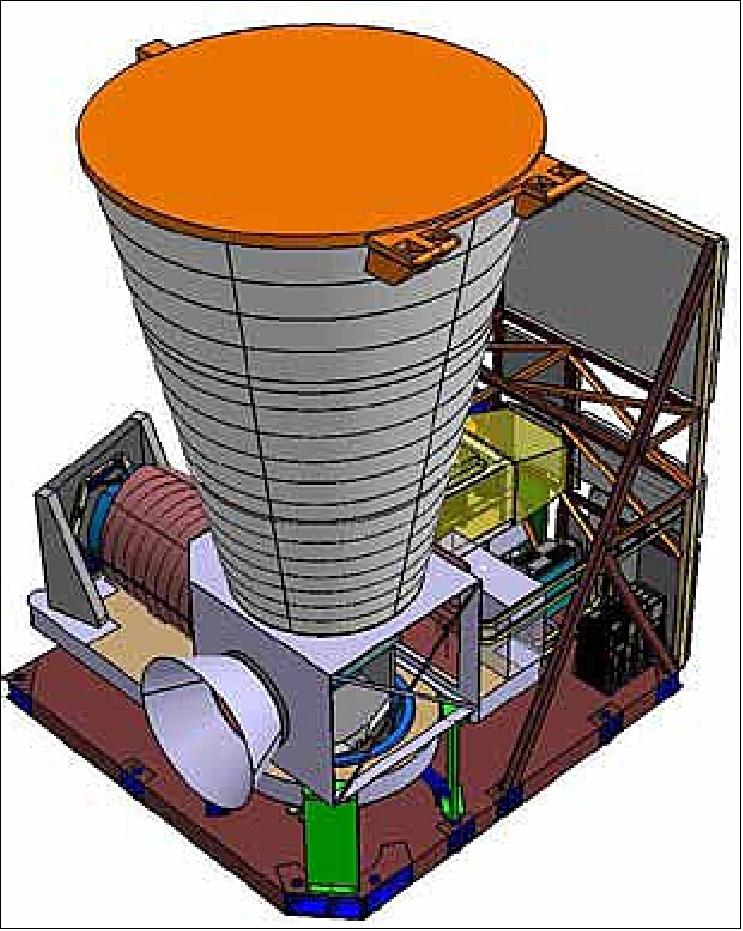
- Spectral bands of interest: MWIR: 1600 to 2250 cm-1 (4.44- 6.25 µm) and LWIR: 680 to 1210 cm-1 (8.26- 14.70 µm).
- Full disk coverage in one hour
- On-ground resolution of 4 km x 4 km
- Radiometric measurement ranges between 180 K and 313 K (equivalent black-body temperature)
- Spectral radiometric noise (excluding spectral calibration) at 280 K blackbody: between 170 and 900 mK depending on the considered wave-number inside the band of interest.
Considering these performance drivers at instrument level, the following design choices and associated performance budget have been flown-down and proposed for the detection chain:
- Two 160 x 160 staring arrays at 90 µm pitch, cooled at 55 K
- 16 bit resolution video chain, operated at 2 Gbit/s
- Number of useful loads (or electrons) to be stored: 30 Mega-electrons in MWIR, 440 Mega-electrons in LWIR, in the useful bandwidth, considering 395 µs integration period
- SNR flux of 280 K at instrument input: 8800 for LWIR band
- Residual non-linearity after correction: 0.05%.
These figures are very challenging and cannot rely on existing space heritage in Europe. Hence, a representative detection chain breadboard has been developed and tested to secure the design choices and these high-end performance budgets.
IRS detection chain receives the optical signal from cold optical chain and delivers digitized information to the processing chain of the instrument. The detection chain main subassemblies are the IR detectors, developed and validated by Sofradir and the VCU (Video Chain Unit), developed and validated by Thales Alenia Space - Espana.
The MWIR and LWIR detectors are hybridized on dedicated CMOS silicon ROIC (Read Out Integrated Circuit). This ROIC works in snapshot integration mode, the 'Integration While Read' function is implemented to optimize the frame rate. It takes benefit of a high performance mixed CMOS technology, proposing 5 V as analog voltage, and the use of Metal-Inter-Metal capacitance as analog devices. Thanks to these technological parameters, the maximum handling capacitance requested by the application in LWIR band can be met. The pixel integration capacitances are 2.7 pF (MWIR) and 31.3 pF (LWIR) for ~2.3 V of useful voltage swing.
The focal plane topology is using a 160 x 160 pixel structure at 90 µm pitch, each pixel being composed of 9 sub-pixels of 30 µm pitch with independent integration capacitance. Each sub-pixel can be integrated and read-out independently (imager or high resolution mode) or can be read by averaging all or a part of the 9 sub-pixels (normal or interferogram mode). Acquisitions in high resolution mode at 480 x 480 format will be used by the system for mission purposes, but also to determine defective sub-pixels location. Each sub-pixel of each super-pixel can be deselected independently in order to increase the performance of the super-pixel and to minimize the number of defective super pixels. — The detector ROIC presents 16 analog video outputs. The array is divided into 16 sub-arrays of 160 lines per 10 columns, which leads to have 1600 super-pixels per outputs. Each output can be operated in parallel at 4 Mpixel/s.
The VCU contains two FEEs (Front End Electronics) located close to the detector cryostat and one VAE (Video Acquisition Electronics) device, located on the platform. The FEEs integrate the following functions: first stage of analog amplification, detector signal conversion from pseudo-differential to full differential, detector management items and very low noise detector analog voltage reference for detector biasing. Those biases are able to supply up to 50 mA peak current with a white noise about 15 µV rms. The VAE integrates the following functions: second stage amplification, the 16 bit – 4 MHz analog to digital conversion using VASP (Value Added Service Provider) ASIC. This VASP has been developed by TAS under ESA contract on HIVAC / VASP digitizer, confirming a better performance than the state of the art devices. Detector images are continuously acquired by the VCU with a fixed rate of 2.4 kHz, managing 32 active 16 bit acquisition chains in parallel for both MWIR and LWIR synchronized bands.
CCM (Corner Cube Mechanism)
The CCM of the IRS is a critical subsystem of the interferometer. The primary function of the CCM is to linearly displace one of two corner cubes in order to create an OPD (Optical Path Difference) between both arms of the interferometer. The CCM is based on a design developed for the IASI (Infrared Atmospheric Sounding Interferometers) on the MetOp satellites. As in the IASI MetOp project, Ruag Space Systems Nyon (formerly Mecanex) is responsible for the detailed mechanical design, manufacture and assembly of the mechanical elements of the CCM in close collaboration with CSEM (Centre Suisse d'Electronique et de Microtechnique), Neuchâtel, Switzerland. 58)
The CCM assembly is composed of:
• A linear scanning mechanism including in particular, a flexure guide translation stage, a voice-coil actuator and a LLD (Launch Locking Device) as shown in Figure 40.
• An electrical unit, the ICE (Interferometer Control Electronics), under Syderal-CH responsibility, which allows to control the CCM.
• A control law algorithm embedded in the Interferometer Control Electronics.
The high precision mechanism is designed to achieve low lateral shift deviations, very long life, limited exported forces to the instrument and a launch lock device that generates no shocks. Flexure technology is used throughout the mechanism to achieve the demanding requirements. The critical specification driving the project is the exported forces and speed stability which are minimized by optimizing the control law.
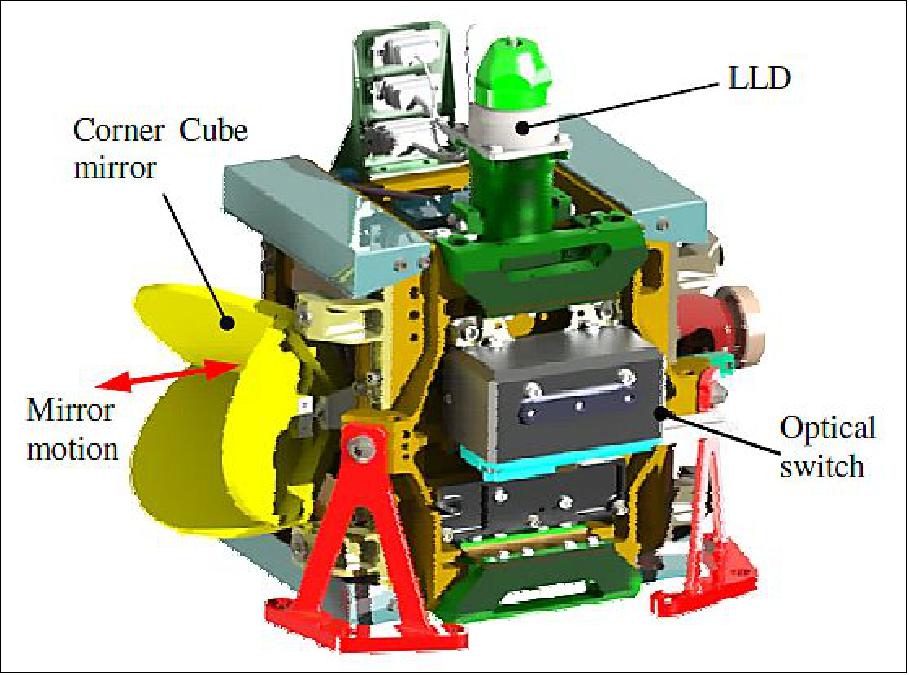
The basic concept of the mechanism has not changed from the IASI application and relies heavily on the flexural structure technology developed by CSEM. In this way, high-accuracy linear guiding is possible without need for sliding surfaces or bearings. Compensated parallelogram flexures are used for the main mechanism constituted by two blade membranes machined in high-strength copper-beryllium alloy. An innovative aspect is given by the driving lever with flexural blades that constrain the motion of the parallelogram in order to dramatically decrease the remaining lateral error caused by the unavoidable manufacturing and assembly tolerances as well as operational dynamics.
The control law being developed by CSEM is based on a state space controller, with position speed and integral of position error as states. A feed-forward is added to improve system time response. Since the CCM speed is low, the control bandwidth is limited to 5.7 Hz with high order modes notched. The controller exhibits robustness with respect to electromechanical parameters.
UVN (Ultra-Violet Near-infrared) Sounder
The UVN sounder on MTG-S is the GEO component of the joint Copernicus Sentinel-4 (GEO) and Sentinel-5 (LEO) concept for climate protocol monitoring and air quality applications expected to deliver data products on ozone, nitrogen dioxide, sulphur dioxide, formaldehyde, aerosol optical depth, and aerosol scattering height.
A separate file, Copernicus: Sentinel-4 (or simply Sentinel-4), is provided on the eoPortal which describes only the UVN Sounder, a hosted payload on the MTG-S spacecraft series.
GEOSAR (Geostationary Search & Rescue) Service
GEOSAR is part of the COSPAS-SARSAT international system; the objective is to provide distress alert and location information to appropriate rescue authorities for maritime, aviation and land users in distress.
DCS (Data Collection System)
The DCS mission involves, as a continuity of the MSG mission, the collection and transmission of observations and data from the ground segment consisting of surface, buoy, ship, balloon or airborne DCP (Data Collection Platforms).
Ground Segment
The ground segment contains the main ground elements necessary to support the mission. They are logically decomposed in facilities as follows: 59)
• GSTF (Ground Station Facilities)
• MOF (Mission Operations Facility)
• IDPF (Instrument Data Processing Facility)
• MPF (Multi-Programme Facilities)
• Infrastructure Facilities and Supporting Facilities
• L2PF (Level 2 Processing Facility), as part of the Application Ground Processing System
• SAF (Satellite Application Facilities).
All system operations will be conducted from the EUMETSAT HQs in Darmstadt, except for the LEOP (Launch and Early Orbit Phase) which will be performed by a LEOP service provider, to be selected. Following the spacecraft hand-over from LEOP, EUMETSAT will then execute the commissioning of the system before entering the routine operations phase. The MTG in-orbit constellation will grow progressively until it will reach its FOC (Full Operational Capability), which consists of 3 operational in orbit satellites (two MTG- I and one MTG-S).
The operational (prime) MTG-I satellite, nominally at 0º longitude, will be set to fulfill the requirements of the FDHSI (Full Disc High Spectral resolution Imagery) mission, with an FCI operating in Full Disk Scanning mode with 10 min repeat cycle. It will also be the nominal operational spacecraft for the other payloads it carries, the LI, the DCP and GEOSAR payloads. The second in-orbit operational MTG-I satellite, expected to be at 9.5º east longitude, will be performing the HRFI (High spatial Resolution Fast Imagery) mission needs, with an FCI operating in Rapid Scanning mode over ¼ of Full Disk with 2.5 min repeat cycle. It will also constitute the in-orbit hot back up for the prime MTG-I satellite (noting that initially an MSG satellite will be the in-orbit hot backup for MTG-I1. The second in-orbit MTG-I satellite may also operate the LI, DCP and GEOSAR payloads in case the corresponding payload becomes not available or for cross-calibration or to improve the quality of the combined ground processing (Ref. 40).
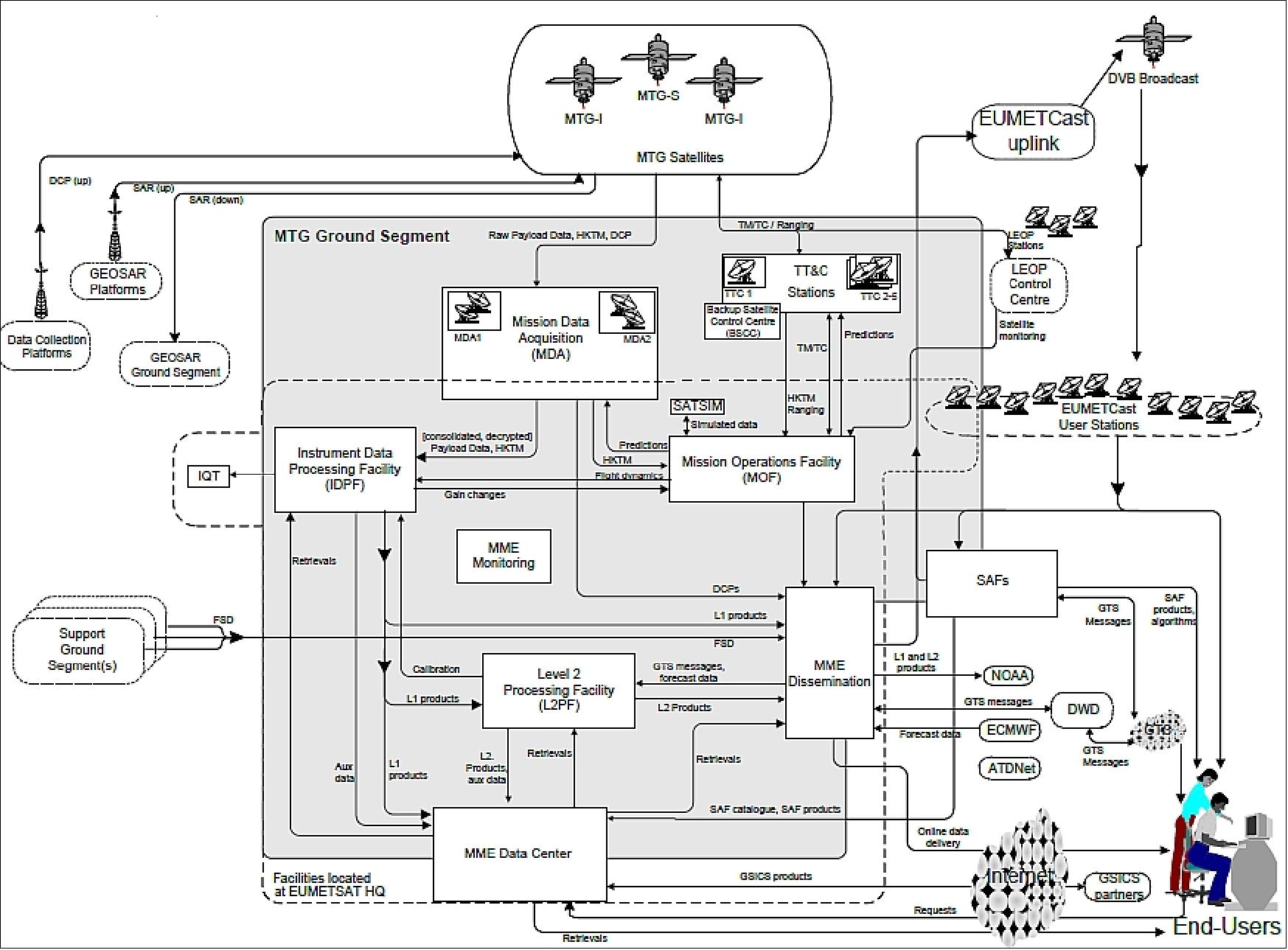
References
1) http://esamultimedia.esa.int/docs/MinisterialCouncil/MC-MTG_1811.pdf
2) Stephen Tjemkes, Rolf Stuhlmann, Antonio Rodriguez, Jean-Loup Bézy, Donny Aminou, Paolo Bensi, “Meteosat Third Generation (MTG) UVS Mission,” URL: http://www.acd.ucar.edu/Events/Meetings/Air_Quality_Remote_Sensing/Presentations/4.11.Tjemkes.pdf
3) Stephen Briggs, “Future Eumetsat-ESA Collaboration - Meteosat Third Generation, Post-EPS and Sentinels 3,4,5,” Portoroz, Slovenia, May 14, 2008, URL: http://www.bridgingthegap.si/pdf/EUMETSAT/Stephen%20Briggs%20-%20Future%20EUMETSAT-ESA%20Collaboration.pdf
4) “Meteosat Third Generation on track,” Dec. 7, 2007, URL: http://www.esa.int/esaLP/SEMV0E29R9F_LPmeteomiss_2.html
5) Jean-Loup Bézy, Donny Aminou, Paolo Bensi, Rolf Stuhlman, Stephen Tjemkes, Antonio Rodriguez, “Meteosat Third Generation – The Future European Geostationary Meteorological Satellite,” ESA Bulletin, No 123, August 2005, pp. 28-32
6) Stephen Tjemkes, “Meteosat Third Generation (MTG) IRS,” URL: http://www.ssec.wisc.edu/hsr/meetings/2006/Presentations/Day%203%20M/MTG-IRS.StephenTjemkes_final.pdf
7) R. Stuhlmann, A. Rodriguez, S. Tjemkes, J. Grandell, A. Arriaga, J.-L. Bézy, D. Aminou, P. Bensi, “Plans for EUMETSAT’s Third Generation Meteosat geostationary satellite program,” Advances in Space Research, Vol. 36, Issue 5, 2005, pp. 975-981
8) J. Schmetz, R. Stuhlmann, M. König, K. Holmlund, E. Koenemann, “EUMETSAT’s Geostationary Satellites as a Part of GEOSS,” AMS Annual Meeting 2008, 5th GOES-R Users‘ Conference, New Orleans, LA, USA, Jan. 23-24, 2008, URL: http://www.goes-r.gov/downloads/GOES_Users_Conference_V/GUC_V_slides/231600%20AMS2008_GOES-R_Users_Conf_schmetz_v18-Jan-2008.pdf
9) Donny Aminou, “Meteosat Third Generation (MTG): Status and Mechanisms Challenges,” ESMATS, 2009, Vienna, Austria,September 22-25, 2009, URL: http://www.esmats.eu/vienna/stuff/MTGMechanismsNeedsAminouPresentation13ESMATS.pdf
10) “Another step towards MTG,” EUMETSAT Image Newsletter, Issue 32, May 2010, p. 1, URL: http://www.eumetsat.int/Home/Main/AboutEUMETSAT/Publications/IMAGENewsletter/groups/cps/documents/document/pdf_image32_en.pdf
11) “Work proceeds on MTG,” EUMETSAT Image, Issue 34, May 2011, URL: http://www.eumetsat.int/Home/Main/AboutEUMETSAT/Publications/IMAGENewsletter/groups/cps/documents/document/pdf_image34_en.pdf
12) Jose M. de Juana, Hilda Meixner, Bruno Mullet, “The challenges associated with Meteosat Third Generation Collocation strategies,” Proceedings of the SpaceOps 2010 Conference, Huntsville, ALA, USA, April 25-30, 2010, paper: AIAA 2010-2255
13) “MTG System: Communication System Requirement Document,” EUMETSAT document No: EUM/MTG/SPE/06/0092, issue: v4B, Feb. 20, 2011, URL: http://www.eumetsat.int/website/wcm/idc/idcplg?IdcService=GET_FILE&dDocName=pdf_mtg_comm_sys_req&RevisionSelectionMethod=LatestReleased&Rendition=Web
14) “MTG System Requirements Document (SRD),” EUMETSAT document No: EUM/MTG/SPE/06/0032, issue: v3L, Nov. 5, 2010, URL: http://www.eumetsat.int/website/wcm/idc/idcplg?IdcService=GET_FILE&dDocName=pdf_mtg_sys_req&RevisionSelectionMethod=LatestReleased&Rendition=Web
15) Hilda Kinter, Dieter Just, Bruno Mullet, “Meteosat Third Generation Navigation Approach,” Proceedings of the 22nd International Symposium on Space Flight Dynamics (ISSFD), Feb. 28 - March 4, 2011, Sao Jose dos Campos, SP, Brazil, URL: http://www.issfd22.inpe.br/S9-Mission.Design-MD/S9_P1_ISSFD22_PF_006.pdf
16) ”Meteosat Third Generation Program Status,” EUMETSAT, 2016, URL: http://www.eumetsat.int/website/wcm/idc/idcplg?IdcService=GET_FILE&dDocName=pdf_mtg_goesr_ws_1&RevisionSelectionMethod=LatestReleased&Rendition=Web
17) Donny M. Aminou, D. Lamarre, Hendrik Stark, Paul Blythe, Gary Fowler, S. Gigli, Rolf Stuhlmann, Sergio Rota, “Meteosat Third Generation (MTG) Status of Space Segment definition,” Proceedings of the EUMETSAT Meteorological Satellite Conference, Bath, UK, Sept. 21-25, 2009, EUM P.55, URL:http://tinyurl.com/jjauhm2
18) ”Meteosat Third Generation (MTG) will see the launch of six new geostationary (imaging and sounding) satellites from 2021 onwards,” EUMETSAT, 2017, URL: https://web.archive.org/web/20201026230149/https://www.eumetsat.int/website/home/Satellites/FutureSatellites/MeteosatThirdGeneration/index.html
19) “Meteosat Third Generation takes a step forward,” Feb. 22, 2010, URL: http://www.esa.int/esaEO/SEMT4I3KV5G_economy_0.html
20) “ESA and Thales Alenia Space enter negotiations for MTG,” March 19, 2010, URL: http://www.esa.int/esaEO/SEMXKUCKP6G_index_0.html
21) “MTG Spanish Industry Day,” TAS, Madrid, Spain, Feb. 8, 2011, URL: http://www.cdti.es/recursos/doc/Programas/Aeronautica_espacio_retornos_industriales/Espacio/17597_1821822011104544.pdf
22) “A new generation of meteorological satellites,” ESA, Feb. 24, 2012, URL: http://www.esa.int/esaCP/SEMTOPKV0ZG_index_0.html
23) Philippe Tanguy, André Smolders, Thomas Miesner, Emanuele Neri, “Meteosat Third Generation: program overview and challenges,” Proceedings of the 63rd IAC (International Astronautical Congress), Naples, Italy, Oct. 1-5, 2012, paper: IAC-12-B1.2.2
24) Manolo Omiciuolo, Andreas Lang, Stefan Wismer, Stephan Barth, Gerhard Székely, ”Micro-vibration performance prediction of SEPTA24 using SMESIM (Ruag Space Mechanism Simulator Tool),” Proceedings of the 15th European Space Mechanisms & Tribology Symposium – ESMATS 2013, Noordwijk, The Netherlands, 25–27 September 2013, URL: http://esmats.eu/esmatspapers/pastpapers/pdfs/2013/omiciuolo.pdf
25) ”SEPTA® 24 Solar Array Drive Assembly,” RUAG brochure, URL: https://manualzz.com/doc/6883106/septa%C2%AE-24-solar-array-drive-assembly
26) Alain Girard, Antoine Provost-Grellier, Jean Nodet, Philippe Desmet, Patrice Cossard, “Overview of Implementing SpaceWire in Observation Satellites from Thales Alenia Space,” Proceedings of the International SpaceWire Conference 2010, St. Petersburg, Russia, June 22-24, 2010, URL: http://2010.spacewire-conference.org/proceedings/Papers/MissionsApplications/Girard.pdf
27) Alain Girard, Alain Degardin, “Spacewire Network in MTG Satellites,” Proceedings of the 5th International SpaceWire Conference 2013, Gothenburg, Sweden, June 10 - 14, 2013, pp: 312-315, URL: http://2013.spacewire-conference.org/downloads/SpW2013ProceedingsFinal.pdf
28) “Astrium will deliver six MTG propulsion systems to OHB,” Airbus DS, July 13, 2013, URL: http://covid-19.chinadaily.com.cn/xinhua/2013-07-10/content_9539423.html
29) ”Weather satellite prepares for lightning,” ESA Applications, 20 April 2022, URL: https://www.esa.int/Applications/Observing_the_Earth/Meteorological_missions/meteosat_third_generation/Weather_satellite_prepares_for_lightning
30) ”MTG-I weather satellite passes tests in preparation for liftoff,” ESA Applications, 23 March 2022, URL: https://www.esa.int/Applications/Observing_the_Earth/Meteorological_missions/meteosat_third_generation/MTG-I_weather_satellite_passes_tests_in_preparation_for_liftoff
31) ”Meteosat Third Generation takes major step towards its first launch,” ESA Applications, 02 September 2021, URL: https://www.esa.int/Applications/Observing_the_Earth/Meteorological_missions/meteosat_third_generation/Meteosat_Third_Generation_takes_major_step_towards_its_first_launch
32) ”A touch of sun,” ESA Enabling & Support, 7 July 2021, URL: https://www.esa.int/ESA_Multimedia/Images/2021/06/A_touch_of_sun
33) ”EUMETSAT and Arianespace confirm the launch of two MeteoSat Third Generation satellites with Ariane 6,” Arianespace Press Release, 23 March 2021, URL: https://www.arianespace.com/press-release/eumetsat-and-arianespace-confirm-the-launch-of-two-meteosat-third-generation-satellites-with-ariane-6/
34) ”RF model of MTG-I,” ESA Technology image of the week , 03 July 2019, URL: http://www.esa.int/spaceinimages/Images/2019/07/RF_model_of_MTG-I
35) ”Surviving the shaker brings better weather forecasting a step closer,” ESA, 2 July 2019, URL: http://www.esa.int/Our_Activities/Observing_the_Earth/Meteorological_missions/Meteosat_Third_Generation/Surviving_the_shaker_brings_better_weather_forecasting_a_step_closer
36) ”Testing MTG’s FCI instrument,” ESA, 4 July 2018, URL: http://m.esa.int/spaceinimages/Images/2018/07/Testing_MTG_s_FCI_instrument
37) ”Meteosat Third Generation,” OHB, 2018, URL: https://www.ohb.de/fileadmin/ohb/Downloads/OHB-System_MTG_2018.pdf
38) Donny M. Aminou, Hendrik Stark, Wolfgang Schumann, Gary Fowler, Stefano Gigli, Antonio Rodríguez, “Meteosat third generation phase A: optical payload consolidation,” Proceedings of SPIE, 'Sensors, Systems, and Next-Generation Satellites XI,' Vol. 6744, Sept. 17, 2007, Florence, Italy, DOI:10.1117/12.737901
39) Donny M. Aminou, Hendrik Stark, Wolfgang Schumann, Gary Fowler, Stefano Gigli, Antonio Rodríguez, “Meteosat Third Generation: progress on space segment system feasibility studies: payload aspects,” Proceedings of SPIE, 'Sensors, Systems, and Next-Generation Satellites XI,' Vol. 7106, Sept. 15, 2008, Cardiff, Wales, UK, DOI:10.1117/12.800244
40) Sergio Rota, Gary Fowler, Paul Blythe, Donny Aminou, Emanuele Neri, “Monitoring weather and climate from the geostationary orbit: The Meteosat Third Generation (MTG) Programme,” Proceedings of the 63rd IAC (International Astronautical Congress), Naples, Italy, Oct. 1-5, 2012, paper: IAC-12- B1.1.1
41) Wolfgang Benesch, “Role and key aspects of the MTG Mission Team (MMT),” 3rd MTG User Consultation Workshop, Darmstadt, Germany, Dec.3-5, 2007
42) S. Demiguel, T. Gilbert, J. L. Canaud, A. Artinian, M. Wilson, “MTG FCI visible detector detection chain description and preliminary results,” Proceedings of the ICSO (International Conference on Space Optics), Tenerife, Canary Islands, Spain, Oct. 7-10, 2014, URL: http://congrexprojects.com/Custom/ICSO/2014/Papers/1.%20Tuesday%207%20October/Session%202A%20Detectors%20for%20Visible/1.65914_Demiguel.pdf
43) J. Ouaknine, T. Viard, B. Napierala, U. Foerster, S. Fray, P. Hallibert, Y. Durand, S. Imperiali, P.Pelouas, J. Rodolfo, F. Riguet, J-L. Carel, “The FCI on board MTG: Optical design and performances,”Proceedings of the ICSO (International Conference on Space Optics), Tenerife, Canary Islands, Spain, Oct. 7-10, 2014, URL: http://congrexprojects.com/Custom/ICSO/2014/Papers/2.%20Wednesday%208%20October/Session%207C%20Images%20-%20Radiometers%20-%20Atmosphere/2.64840_Ouaknine.pdf
44) P. Pidancier, A. Delannoy, K. Madet, P. Chorier, N. Remoué, T. Dartois, “Sofradir detectors for MTG FCI application,” Proceedings of the ICSO (International Conference on Space Optics), Tenerife, Canary Islands, Spain, Oct. 7-10, 2014, URL: http://congrexprojects.com/Custom/ICSO/2014/Papers/2.%20Wednesday%208%20October/Session%207A%20IR%20Detectors%20and%20ASICSs/4.66345_Chorier.pdf
45) Stefano Lorenzini, Lorenzo Giunti, Marco Di Giampietro, Frederic Feresin, Donny M. A. Aminou, Philip Willemsen, ”Lightning Imaging From GEO: An Innovative Sensor For Meteosat Third Generation,” Proceedings of the 67th IAC (International Astronautical Congress), Guadalajara, Mexico, Sept. 26-30, 2016, paper: IAC-16-B1.3.1
46) A. Romoli, L. Gambicorti , A. Zuccaro Marchi, F. Simonetti, R. Bardazzi, D. Labate, “The Lightning Imager Feasibility for the Meteosat Third Generation,” Proceedings of the 7th ICSO (International Conference on Space Optics) 2008, Toulouse, France, Oct. 14-17, 2008
47) Jochen Grandell, Ullrich Finke, Stefano Gigli, Rolf Stuhlmann, “The EUMETSAT Meteosat Third Generation Lightning Imager (MTG-LI): Applications and Product Processing,” EMS Conference, Toulouse, France, Sept. 30, 2009
48) Daniele Biron, Luigi De Leonibus, Paolo Laquale, Demetrio Labate, Francesco Zauli, Davide Melfi, “Simulation of Meteosat Third Generation - Lightning Imager through Tropical Rainfall Measuring Mission – Lightning Imaging Sensor data,” Proceedings of SPIE, Vol. 7087, 'Remote Sensing System Engineering,' 708706, San Diego, CA, USA, August 25, 2008, doi:10.1117/12.794764
49) S. Lorenzini, R. Bardazzi, M. Di Giampietro, F. Feresin, M. Taccola, L. Perez Cuevas, “Optical design of the Lightning Imager for MTG,” Proceedings of the ICSO (International Conference on Space Optics), Ajaccio, Corse, France, Oct. 9-12, 2012, paper: ICSO-072
50) “On 7 February in Florence, Italy, EUMETSAT Director-General Alain Ratier attended the signing of the contract for the lightning imager (LI) of the future Meteosat Third Generation (MTG) satellite,” EUMETSAT, Feb. 7, 2013, URL: [web source no longer available]
51) Jochen Grandell, Marcel Dobber, Rolf Stuhlmann,“Geostationary Lightning Observations in Support of NWC and Severe Weather Monitoring,” European Severe Storms Conference, Helsinki, Finland, 5 June 2013, URL: http://www.essl.org/ECSS/2013/programme/presentations/16.pdf
52) Sébastien Rolando, Vincent Goiffon, Pierre Magnan, Franck Corbière, Romain Molina, Michel Tulet, Michel Bréart-de-Boisanger, Olivier Saint-Pé, Saïprasad Guiry, Franck Larnaudie, Bruno Leone, Leticia Perez-Cuevas, Igor Zayer, “Smart CMOS Image Sensor for Lightning Detection and Imaging,” Applied Optics, Vol. 52, 2013, No 7, pp. C16-C23. ISSN 0003-6935, URL: http://oatao.univ-toulouse.fr/10211/1/Rolando_10211.pdf
53) Jochen Grandell, Rolf Stuhlmann, “Diffraction Effects on the Meteosat Third Generation Infrared Sounder (MTG IRS),” Proceedings of IGARSS 2007 (International Geoscience and Remote Sensing Symposium), Barcelona, Spain, July 23-27, 2007
54) Johannes Schmetz, Rolf Stuhlmann, P. Schlüssel, D. Klaes, “Relevance of NWP Impact Studies for Future Satellite Programs,” 4th WMO Workshop on the Impact of Various Observing Systems on NWP, Geneva, Switzerland, May 19-21, 2008, URL: https://web.archive.org/web/20170607062325/https://www.wmo.int/pages/prog/www/OSY/Meetings/NWP-4-Geneva2008/3a5_Schmetz.ppt
55) D. Lamarre, P. v. d. Braembussche, M. Wilson, P. Hallibert, A. Zuccaro Marchi, T. Guggenmoser, A. Mora, D. Aminou, P. Blythe, ”Meteosat Third Generation (MTG) IRS Overall Design and Performance,” EUMETSAT Meteorological Satellite Conference 2018, Tallinn, Estonia, 17-21 September 2018
56) “MTG - Meteosat Third Generation,” Kayser Threde, 2012, URL: http://www.kayser-threde.de/2012-08_KT-MTG-low.pdf
57) D. Dumestier, F. Pistone , T. Dartois, E. Blazquez, “MTG Infrared Sounder Detection Chain: First radiometric test results,” Proceedings of the ICSO (International Conference on Space Optics), Tenerife, Canary Islands, Spain, Oct. 7-10, 2014, URL: http://congrexprojects.com/Custom/ICSO/2014/Papers/2.%20Wednesday%208%20October/Session%207A%20IR%20Detectors%20and%20ASICSs/3.65873_Dumestier.pdf
58) Peter Spanoudakis, Philippe Schwab, Lionel Kiener, Hervé Saudan, Gérald Perruchoud, ”Development challenges of utilizing a corner cube mechanism design with successful IASI flight heritage for the Infrared Sounder (IRS) on MTG; recurrent mechanical design not correlated to recurrent development,” Proceedings of the 16th European Space Mechanisms and Tribology Symposium 2015, Bilbao, Spain, 23–25 September 2015 (ESA SP-737, September 2015)
59) Torsten Esdar, Fran Martínez Fadrique, Steven Reed, “The Mission Operations Facility design and operational concept for EUMETSAT’s next generation geostationary satellite program (MTG),” SpaceOps 2014, 13th International Conference on Space Operations, Pasadena, CA, USA, May 5-9, 2014, paper: AIAA 2014-1860
60) Fausto Roveda, Rafael Zarza, “Data Processing Systems of EUMETSAT's Meteosat Third Generation,” Proceedings of the 63rd IAC (International Astronautical Congress), Naples, Italy, Oct. 1-5, 2012, paper: IAC-12.B1.4.3
61) “The Meteosat Third Generation satellite system is set to revolutionise weather forecasting and enable more precise monitoring of our changing atmosphere, land and oceans”, URL: https://www.eumetsat.int/meteosat-third-generation
62) The European Space Agency,“European satellite strikes lightning” July 3, 2023, URL: https://www.esa.int/Applications/Observing_the_Earth/Meteorological_missions/meteosat_third_generation/European_satellite_strikes_lightning